
- Charter & Brokerage
- Yacht Design & New Builds
- Tenders & Toys
- Superyacht Events Calendar
- Career & Training
- Departments
- Superyacht Crew Finances
- Sustainability
- Shipyards and Marinas
- Health & Wellbeing
- Polar Region
- Our Services
- Meet the Team

Yachts And Fuel – How Much Do They Really Consume?
.png)
Fuel is one of many annual running costs of a yacht. Not only does the yacht need fuel for cruising; the generators require it to keep the vessel running while at anchor and underway. As well as this, many of the water sports toys require it too.
Some yachts cross the Atlantic Ocean twice a year between the Mediterranean and Caribbean while others embark on world cruises. That equates to a lot of fuel.
So How Much Do They Really Consume?
According to the Yachting Pages, the longest Superyacht in the world, 180m M/Y Azzam, holds 1,000,000 litres of fuel. To put it into perspective, that is the equivalent of filling a regular hatchback car 23,800 times. Or, six Boeing 747 commercial airliners.
West Nautical’s Vessel Manager, Tony Hildrew, a former Yacht Chief Engineer said:
“Fuel is the single biggest expense when it comes to yacht operations, it is estimated that the global spend on fuel is around $150bn annually however this shouldn’t put you off, there are a number of ways to ensure your fuel consumption doesn’t get out of hand. Implementing a Ships Energy Efficiency Management Plan or SEEMP for short is a great way to keep fuel costs down without compromising on your cruising experience.”
Each yacht will consume fuel differently for a number of reasons. It could be the size and make of the engines. Or, how often the yacht is using generators. As well as the number of tenders and water sports toys on board that require fuel. For example, if the yacht is out at anchor and running on generators 90% of the time, the fuel consumption will be much higher than a yacht that is in a marina at night and connected to shore power and water.
Another factor that will affect fuel consumption is the yacht’s itinerary. This is because the sea conditions will impact how much fuel the engines consume.
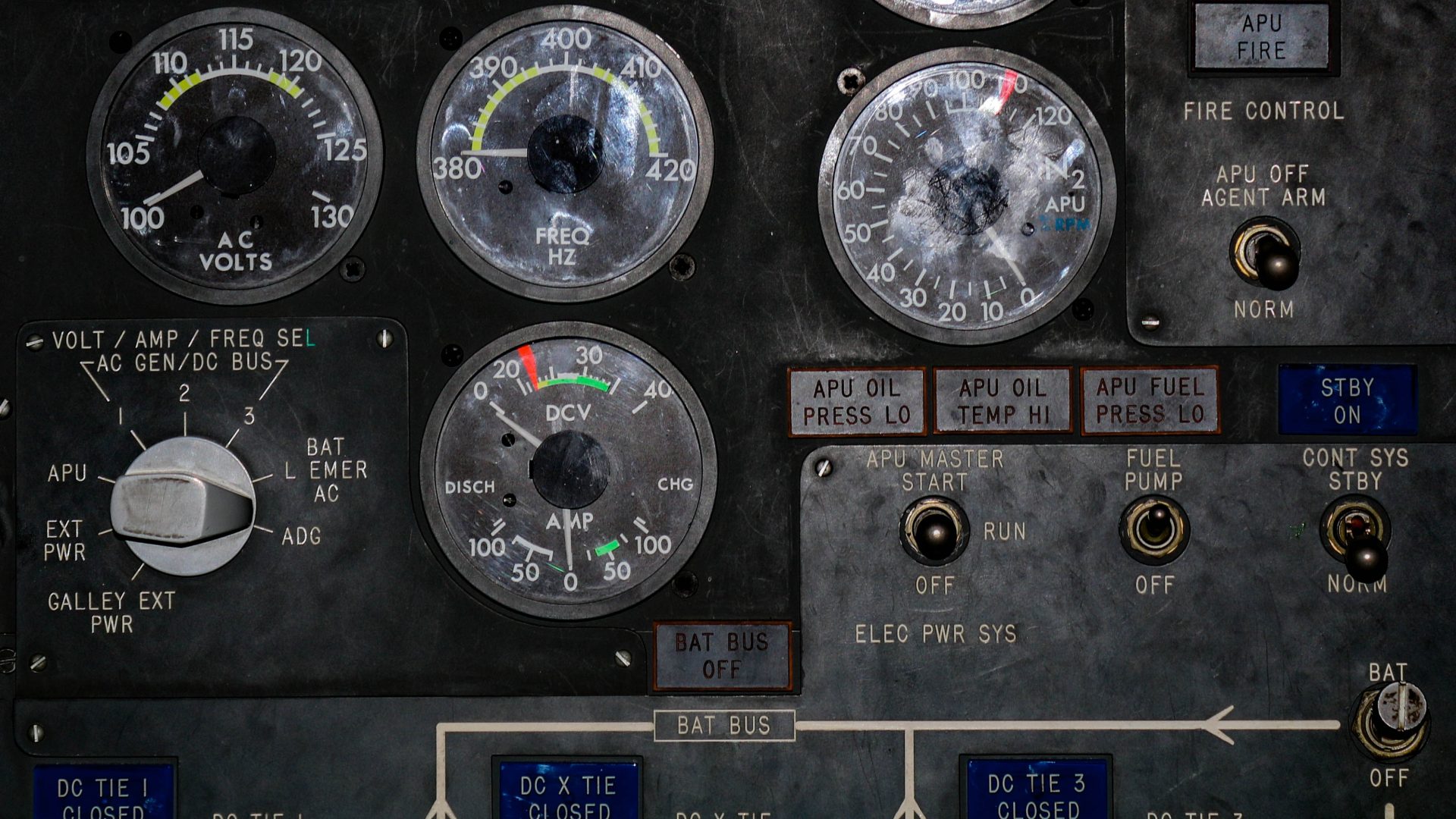
How Is Consumption Measured?
You will be able to input the start and ending points of your cruise on the map. This will automatically update the distance table. The next step is to enter the speed, fuel consumption and cost of fuel per litre to determine the cost of the trip.
Here is an example: A fast 30m yacht cruising at 20 knots will consume roughly 400 – 500 litres depending on the engine type. This would equate to the total consumption of 2500 litres for a distance of 100 nautical miles.
Another example is, a 70m yacht looking to travel 100 nautical miles with the engines burning 1000 litres per hour would add up to a total consumption of 8335L for that passage. Depending on where the yacht bunkered, the estimated cost with the price per litre being on the low end at €0.90 per litre would cost a total of €7501.50. An example of a 100 nautical mile passage would take you from Saint Tropez to The North Coast of Corsica.
How Much Does It Cost?
Fuel prices fluctuate depending on which country you bunker in and some places you bunker offer tax free fuel such a Gibraltar and Montenegro. Fuel prices can vary but typically costs between €0.80 and €1.30 per litre.
Yacht charter, sales and management company West Nautical added:
“Fuel costs should be at the top of any yacht owner and captain’s minds for two reasons: to minimise costs as well as reduce the environmental impact of burning unnecessary fuel. The superyacht charter market, more than most other markets, relies on pristine waters for their guests to enjoy their holiday. If the oceans in popular charter destinations are not maintained, it will decrease the demand for yacht charter and therefore the revenue for owners.” “If you are looking for expertise in operational management and engineering in order to plan a SEEMP, West Nautical would be delighted to assist.”
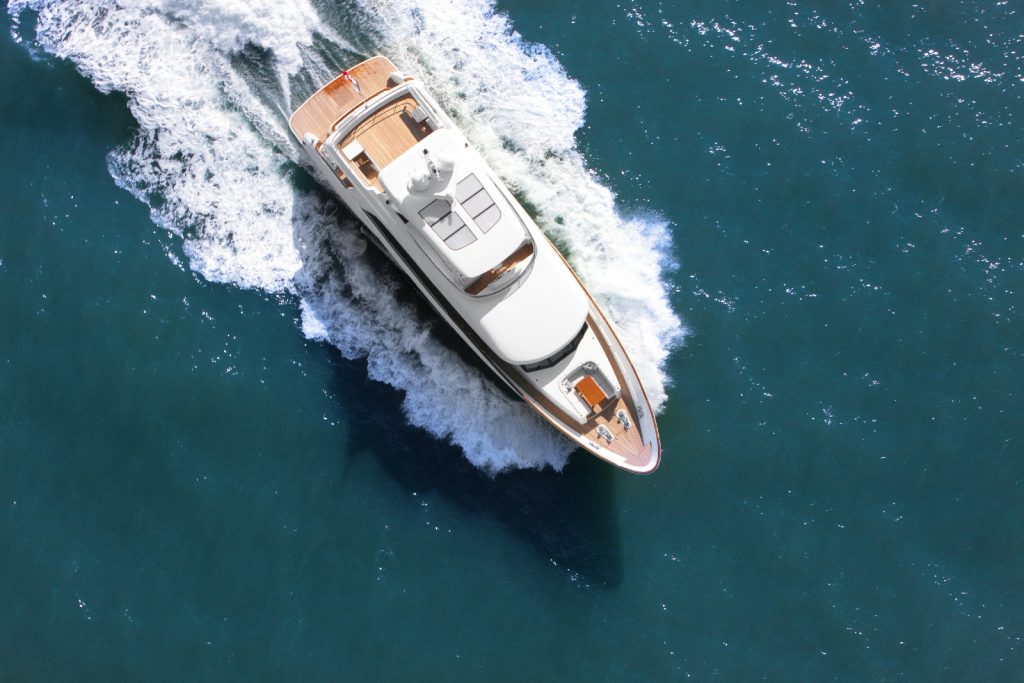
About West Nautical
West Nautical sell, charter and manage superyachts from their head office in Newcastle upon Tyne. The business currently employs a team of 21 staff throughout their offices based in the UK, Russia, France and Cyprus.
Since their inception over 25 years ago, West Nautical have become recognised as one of the most respected, trusted, knowledgeable and accountable professional services firms in yachting – largely due to their relentless determination to act in our clients’ best interests. Their approach and attitude is transparent, refreshing and focused on providing value-added services delivered simply, elegantly and affordably.
Visit West Nautical’s website here: https://westnautical.com
For Media enquiries please contact sarah.mackenzie@westnautical.com
To keep up to date with the latest Superyacht Content News, click here .
Sign up to our Newsletter below:
Newsletter Signup
- Your Name First Last
- Your Email *

West Nautical
Related articles, scorpion tenders from twisted marine. setting world class standards, navigating busy season: crew wellness tips with superyacht fitness & emma from seas the mind, tender of the week: maori 54 xl, the below deck effect. reality tv & the world’s top 1%.

Superyacht Content
Social media influencer and digital brand expert.
Superyacht Content brings you the latest in social news for the superyacht industry.
Keep up to date with us across our social channels, and don’t forget to hit that share button!
- Superyacht News
- Superyacht Jobs
- Superyacht Marketing
Join our Newsletter
Copyright © 2023 Superyacht Content | Website Design by Zonkey
Privacy | Credits | Get in Touch
How Much Fuel Does a Yacht Use? An In-Depth Analysis
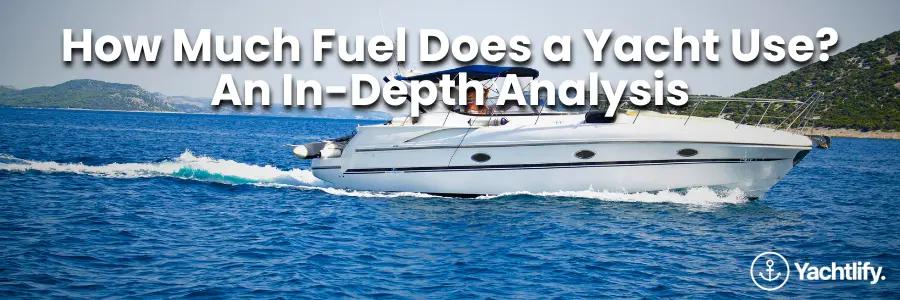
When it comes to luxury and adventure on the high seas, yachts are the epitome of both. Whether you’re a yacht owner or dreaming of chartering one for your next vacation, understanding the fuel consumption of these majestic vessels is crucial. Fuel usage not only impacts the cost of your journey but also has environmental implications. In this article, we dive into the factors affecting yacht fuel consumption and provide insights to help you estimate how much fuel a yacht uses.
Understanding Yacht Fuel Consumption
Fuel consumption in yachts is influenced by several factors, including the yacht’s size, engine type, cruising speed, and conditions at sea. Here, we break down these elements to give you a clearer picture.
Yacht Size and Engine Type
Yachts come in various sizes, from smaller 40-foot models to massive 100-foot plus luxury liners. Generally, the larger the yacht, the more fuel it consumes. Engine type also plays a significant role. Traditional diesel engines are common, but newer models may feature more efficient or hybrid engines that can impact fuel usage.
Cruising Speed
Speed is a significant factor in fuel consumption. Higher speeds increase resistance in the water, requiring more power and, consequently, more fuel. Cruising at a yacht’s optimal speed, often referred to as the “hull speed,” can help maximize fuel efficiency.
Conditions at Sea
Sea conditions can also affect fuel consumption. Smooth, calm waters allow for more efficient travel, while rough seas can increase fuel use due to the additional power needed to maintain speed and stability.
Estimating Yacht Fuel Consumption
While it’s challenging to provide a one-size-fits-all answer due to the variables involved, we can offer some general guidelines. On average, a yacht might use between 20 to 100 gallons of fuel per hour. Smaller yachts, such as those around 40 feet, tend to be on the lower end of the scale, consuming about 20 to 40 gallons per hour. Larger vessels, which are over 100 feet, can consume significantly more, sometimes exceeding 100 gallons per hour, especially at higher speeds.
Example Calculations
Let’s look at an example. For a 70-foot yacht cruising at a moderate speed of 20 knots, fuel consumption could be around 50 gallons per hour. If you’re planning a 100-mile journey, at 20 knots, it would take you approximately 5 hours. This means the total fuel consumption for the trip could be around 250 gallons.
Tips for Reducing Fuel Consumption
- Cruise at Efficient Speeds: Find and maintain your yacht’s hull speed for optimal fuel efficiency.
- Regular Maintenance: Keep the engine and hull in top condition to reduce drag and ensure the engine runs efficiently.
- Plan Your Route: Opt for the most direct route and consider current sea conditions to minimize unnecessary fuel use.
- Lighten Your Load: Only carry what you need for your journey, as extra weight can increase fuel consumption.
Understanding and managing fuel consumption is crucial for any yacht owner or enthusiast. By considering the factors outlined above and implementing fuel-saving strategies, you can enjoy the luxury of yachting more sustainably and cost-effectively. Whether planning a short excursion or a long voyage, a careful consideration of fuel use will enhance your experience on the water.
Remember, every yacht is unique, and so is its fuel consumption. For specific figures, consult your yacht’s manual or speak with a marine professional who can provide insights tailored to your vessel. Enjoy your time at sea, and sail smartly!
Listing your boat with Yachtlify provides several unique benefits, including:
- List once, post on multiple platforms (Yachtlify.com, Facebook Marketplace, Instagram, and others).
- Schedule showings and sea trials with our calendar and reminders.
- View listing engagement analytics across platforms.
- eSign, state forms, and Coast Guard forms to manage closing documentation in once place.
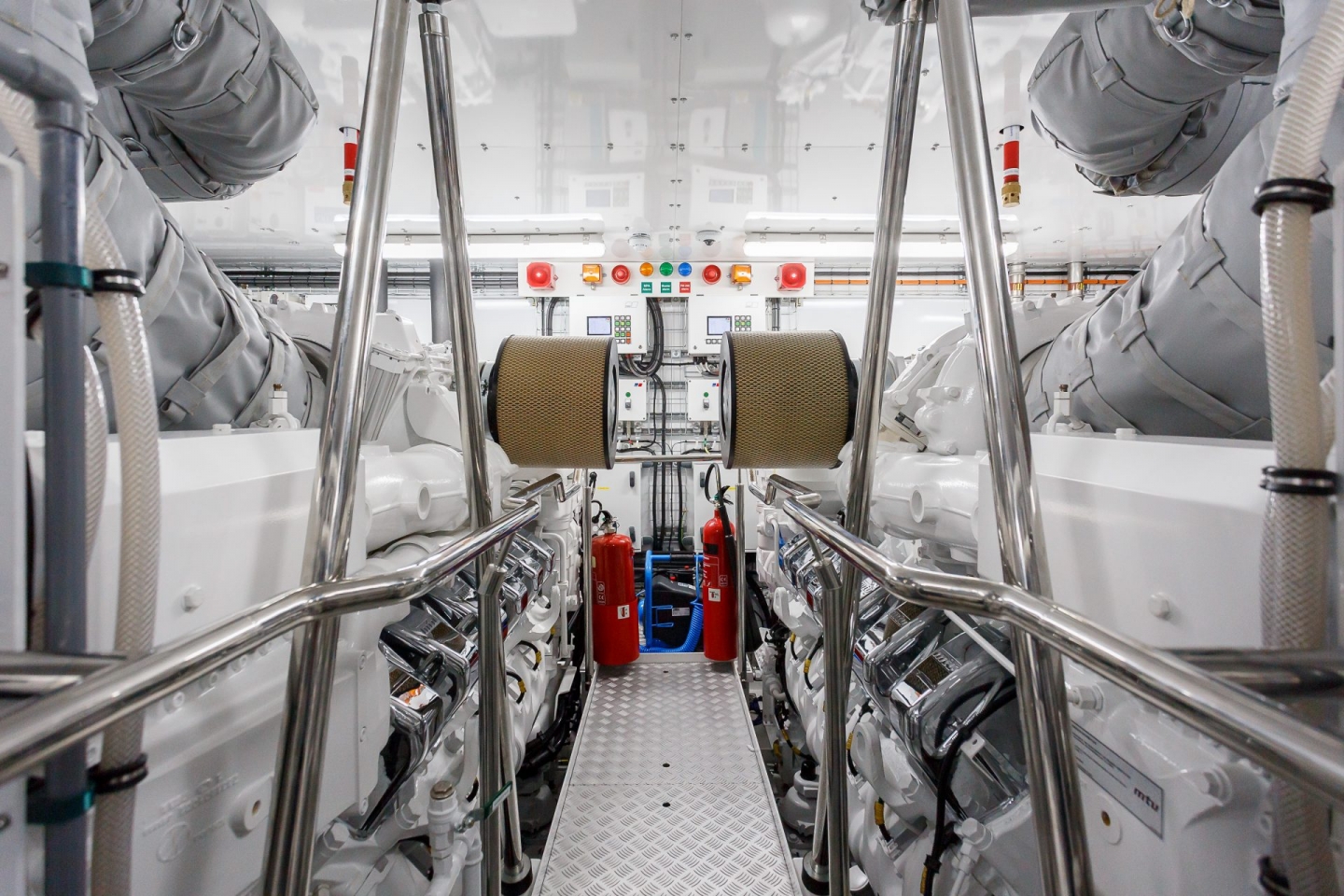
Superyachts are the most elite asset a person can own, your own private yacht to cruise the world’s most beautiful destinations. Some yachts cross the Atlantic Ocean twice a year between the Mediterranean and Caribbean while others embark on world cruises.
Fuel is one of many annual running costs of a yacht and not only does the yacht need fuel for cruising; the generators require fuel to keep the vessel running while at anchor and underway, as well as many of the water sports toys requiring fuel.
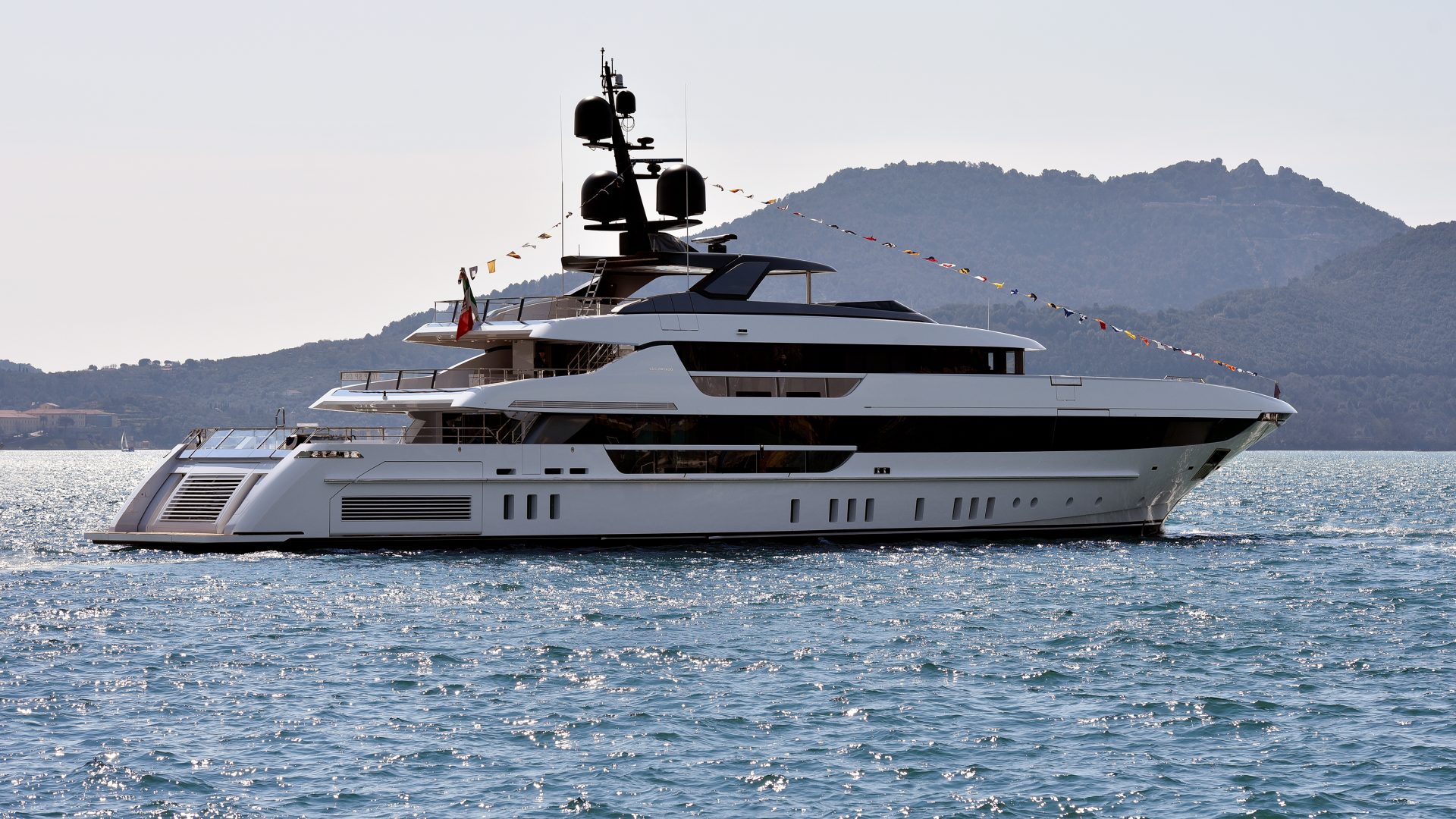
So how much do they really consume?
According to the Yachting Pages, the longest Superyacht in the world, 180m M/Y Azzam, holds 1,000,000 litres of fuel. To put it into perspective, that is the equivalent of filling a regular hatchback car 23,800 times or six Boeing 747 commercial airliners.
West Nautical’s Vessel Manager, Tony Hildrew, a former Yacht Chief Engineer said: “Fuel is the single biggest expense when it comes to yacht operations, it is estimated that the global spend on fuel is around $150bn annually however this shouldn’t put you off, there are a number of ways to ensure your fuel consumption doesn’t get out of hand. Implementing a Ships Energy Efficiency Management Plan or SEEMP for short is a great way to keep fuel costs down without compromising on your cruising experience.”
Each yacht will consume fuel differently for a number of reasons – the size and make of the engines, how often the yacht is using generators and the number of tenders and water sports toys on board that require fuel. For example, if the yacht is out at anchor and running on generators 90% of the time, the fuel consumption will be much higher than a yacht that is in a marina at night and connected to shore power and water.
Another factor that will affect fuel consumption is the yacht’s itinerary as the sea conditions will impact how much fuel the engines consume.
Fuel consumption is often measured in litres per hour, the best way to calculate the total fuel consumption for your itinerary is by using a fuel calculator like the one found here on the West Nautical website.
You will be able to input the start and ending points of your cruise on the map, this will automatically update the distance table. The next step is to enter the speed, fuel consumption and cost of fuel per litre to determine the cost of the trip.
Here is an example: A fast 30m yacht cruising at 20 knots will consume roughly 400 – 500 litres depending on the engine type, this would equate to the total consumption of 2500 litres for a distance of 100 nautical miles.
Another example is, a 70m yacht looking to travel 100 nautical miles with the engines burning 1000 litres per hour would add up to a total consumption of 8335L for that passage. Depending on where the yacht bunkered, the estimated cost with the price per litre being on the low end at €0.90 per litre would cost a total of €7501.50. An example of a 100 nautical mile passage would take you from Saint Tropez to The North Coast of Corsica.
Fuel prices fluctuate depending on which country you bunker in and some places you bunker offer tax free fuel such a Gibraltar and Montenegro. Fuel prices can vary but typically costs between €0.80 and €1.30 per litre.
Yacht charter, sales and management company West Nautical added; “Fuel costs should be at the top of any yacht owner and captain's minds for two reasons: to minimise costs as well as reduce the environmental impact of burning unnecessary fuel. The superyacht charter market, more than most other markets, relies on pristine waters for their guests to enjoy their holiday. If the oceans in popular charter destinations are not maintained, it will decrease the demand for yacht charter and therefore the revenue for owners.” “If you are looking for expertise in operational management and engineering in order to plan a SEEMP, West Nautical would be delighted to assist.”
Page Loading
- Vessel ltinerary
- Administration
- Dockage & Fuel
- Maintenance
- Capital Repairs & Reserves
- Total Expenses =
- Name Length Build
- # Total Expenses Date Saved
Advanced functionality coming soon.
Us flagged vessel, health insurance costs per crew, uniform cost per crew, training cost per crew, food cost per crew, crew turnover, hires using a professional crew agency.
- Restore Default
- $ | € | £
Costs of food provisions will vary dependent upon how eloborate food Preferenaces are
Location will play huge factor in food provisons and thing may have to be folws into remorte locations.
Crew is one of the largest expenses on a superyacht and critical to the owner’s enjoyment of their vessel. As the largest crew agency in the world, we know crew. Our cost calculator contains customized crew lists for yachts ranging from 80ft to 600ft with salary information based on our reference verified salary data.
Our users also have the ability to completely tailor the crew list to the specific needs, schedule and requirements of their vessel. Each yacht is unique and may have specific owner requests in addition to the yacht’s safe manning requirements.
Management of the supplemental crew costs and strategic budgeting can help avoid significant overspend on categories such as food and uniform. This tool contains default values based on our industry expertise and recommended budget for an efficiently and safely run superyacht.
To learn more about each crew position in detail, including salary ranges, please visit our yacht department directory .
Drag the sliders to modify your results. These are not linear scales and we expect most yachts to operate within the 20-80% window. Above 80% and below 20% costs increase or decrease at exaggerated levels and we only see numbers in these levels in very rare circumstances.
This sunburst diagram is interactive. You can click into each block to see the expense break down and mouse over each block for more details.
Our chart of accounts displays seven major categories, 20 sub-categories plus a further 80 detail categories for a total of 107.
Our yacht operating cost calculator is now on it’s third major revision. We start with actual yacht expense data from our yacht management accountants and then generate formulas to extrapolate out the budget for a wide range of yachts. We have been providing accounting services to large yachts for the past 18 years.
Our operating cost calculator is tuned for yachts from 80 to 600 feet. We find operating variables create the largest variances for yachts smaller than 100 feet and larger than 250 feet. We have tested the numbers the most in the range from 100 to 250 feet.
Our budget calculator factors in the fuel burn for a range of engine sizes typically seen installed on yachts by length. By dragging the green “fuel dockage” slider to the right you will increase the projected fuel burn rate and therefore the budget cost for fuel. Our default position would be for a typical displacement fuel burn. Position the slider in the 60-80% range for fuel projections for planning hulls.
Our default values produce a budget number that we believe is generous to run a yacht to a high standard. Perfect is a very expensive word to use in the yachting industry where standards are already high. Moving the crew and maintenance sliders to 80% will provide an “industry best” quality of crew and give them the maintenance budget to operate to a very high standard. If you need to go over the 80% area then you may have unusually labor intensive equipment on the yacht.
Yes, our yacht operating cost calculator can output a budget suitable for this situation. Adjust the owner use to 2 (minimum value), owner slider to 0, crew slider to 10%, Administration to 10%, Fuel and Dockage to 0, Maintenance to 10% and then Capital Repairs to 0. This will remove all of the large charges associated with owner use and vessel movement but leave the essential base maintenance and insurance in place.
Lift on and float in yacht transport is a popular way to transport yachts across large ocean passage. The yachts that this service certainly applies to are ones that may not have the motoring range or structural integrity for blue ocean cruising. The cost of transporting a yacht twice per year is put into our budget once the “Fuel Dockage” slider hits 75%. If your yacht has the range we recommend self-sufficient ocean passages whenever possible. Whilst the transport companies sell their services based upon reportedly well oiled operated schedules the reality is that your yacht may stay waiting for pickup for a week or more with no compensation due. When factoring in all secondary factors of self-sufficient passages (increased fuel, maintenance, potential storm damage, crew time off, extra delivery crew) compared with transporting your yacht (insurance, potential loading / unloading damage, loss of schedule control, no work whilst underway, crew flights, crew accommodation) we believe that there is a 100% premium associated with float in transport and a 75% premium with lift on transport compared with self-powered.
Abandoned yachts crash in value. We recommend that even if you are trying to sell your yacht that you use the yacht for a minimum of two weeks per year so that systems are tested and working every six months. There is nothing worse for a yacht than not being used. If you truly are not going to use the yacht then you should sell it immediately for the first genuine offer as every dollar you put into maintenance will not be recovered at the time of the sale.
We did not build this version with sailing yachts in mind. Early in our development of this version we decided to exclude sailing yachts as a few of the major cost drivers scale very differently for sailing yachts compared with motor yachts. For example: To calculate paint costs we reviewed the surface area of over 100 large yachts and created a formula for painted surface area to length. Sailing yachts just don’t scale in a consistent way. Similarly crew numbers don’t scale in the same manner that they do for motor yachts. If there is sufficient demand we may build a sailing selector switch into a future version of this tool.
We hate to hear when yacht owners were told by their broker to factor in 10% of the purchase price to operate the yacht. This over used saying is sadly right occasionally (particularly for newer yachts in the $20-30M range)… but just because a broken watch tells the right time twice a day you shouldn’t rely upon it to tell the time. As yachts get older their capital value decreases but their maintenance costs increase. There is no way that a fixed 10% of purchase cost rule can be true… if your broker told you this rule then you need a new yacht broker… we know some good ones. 😊
Advanced functionality coming soon…
We are building advanced tools to allow you even greater control over our operating cost calculator. Please enter your email address below to be advised when it is available.
Save this version
Share your calculations.
Please save version before sharing LuxYacht - Calculator!!
You must be logged in to save this version of the cost calculator that you have customized for your yacht..

How Much Fuel Does a Superyacht Hold? Find Out Here
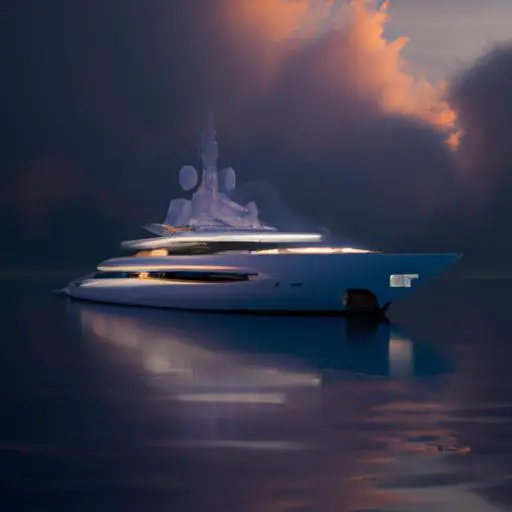
Ever wondered how much fuel a superyacht can hold? Have you been curious about the factors that determine a superyacht’s fuel capacity? Or maybe you’re interested in learning how to maximize fuel efficiency? Well, you’re in the right place! In this article, we’ll explore all of these topics and more.
We’ll dive into the different types of engines and fuel efficiency, the average fuel capacity of a superyacht, the largest fuel capacity for a superyacht, the benefits of having a larger fuel capacity, how to maximize fuel efficiency, and tips for conserving fuel.
So, let’s get started!
Table of Contents
Short Answer
The amount of fuel a superyacht holds varies greatly depending on the size and type of yacht.
Generally, a superyacht can hold anywhere from 5,000 to 30,000 gallons of fuel.
Larger vessels can hold up to 50,000 gallons or more.
Additionally, some superyachts are equipped with multiple fuel tanks to store more fuel for longer voyages.
Factors that Determine the Fuel Capacity of a Superyacht
When it comes to determining how much fuel a superyacht holds, there are a number of factors that come into play.
The size and type of the yacht are the two most important factors to consider.
Generally speaking, a superyacht typically holds anywhere from 15,000 to 50,000 gallons of fuel, though some larger vessels can hold upwards of 200,000 gallons.
The range and cruising speed of a superyacht, as well as the type of engines used on the yacht, are also key factors in determining the amount of fuel the yacht will need to store.
As a general rule, larger and faster yachts require more fuel to travel longer distances.
Additionally, the fuel efficiency of the yacht will also have an impact on the total fuel capacity.
The more efficient the yacht, the less fuel it will need to travel the same distance.
Finally, the purpose of the yacht will also play a role in determining the fuel capacity.
Yachts that are used for racing or long-distance cruising will need more fuel than ones that are used primarily for short-distance trips or pleasure cruising.
In addition, the fuel storage capacity of the yacht will be determined by the number of tanks installed and the size of the tanks.
Ultimately, the amount of fuel a superyacht holds will vary greatly depending on a variety of factors.
The size and type of the yacht, its range and cruising speed, the type of engines used, and the fuel efficiency of the yacht will all have an impact on the total fuel capacity.
Additionally, the purpose of the yacht and the size of the fuel tanks will also determine how much fuel a superyacht can hold.
Types of Engines and Fuel Efficiency

When considering the total fuel capacity of a superyacht, it is important to consider the type of engines and fuel efficiency of the vessel.
The type of engines used will impact the fuel efficiency and ultimately the amount of fuel the yacht will need to store.
Traditional diesel engines are typically more fuel efficient than gas-powered engines, and may require a smaller fuel capacity.
On the other hand, gas-powered engines may require a larger fuel capacity due to their lower efficiency.
Additionally, some superyachts feature hybrid propulsion systems, which combine diesel and electric power to achieve greater fuel efficiency.
In addition to the type of engine, the fuel efficiency of the vessel is determined by several other factors.
The yachts weight, hull shape, and speed all influence fuel efficiency, with lighter, more efficient hulls and slower cruising speeds allowing for greater fuel efficiency.
Additionally, the use of fuel-saving technologies such as advanced propellers and energy-saving sails can also improve fuel efficiency, allowing for a smaller fuel capacity.
Ultimately, the type of engines and fuel efficiency of a superyacht will have a significant impact on the total fuel capacity of the vessel.
By carefully considering these factors, it is possible to optimize a superyachts fuel efficiency and minimize the total fuel capacity required.
Average Fuel Capacity of a Superyacht
When it comes to the fuel capacity of a superyacht, the amount varies greatly depending on the size and type of the vessel.
Generally speaking, a superyacht typically holds anywhere from 15,000 to 50,000 gallons of fuel.
However, some larger vessels can hold upwards of 200,000 gallons.
The amount of fuel a superyacht holds is largely determined by the vessel’s range and cruising speed, as larger and faster yachts will require more fuel to travel longer distances.
In addition to the range and cruising speed of the vessel, other factors such as the type of engines, as well as the fuel efficiency of the yacht, can also have an impact on the total fuel capacity.
For instance, if the yacht has higher-performance engines, it may require more fuel to sustain the speed and range of the vessel.
On the other hand, if the yacht has more efficient engines, it may be able to cover more distance with less fuel.
In addition to the engine type and fuel efficiency, the type of fuel also plays a role in determining the fuel capacity of a superyacht.
Diesel-powered yachts typically have a higher fuel capacity than gasoline-powered yachts, as diesel engines are more fuel-efficient than their gasoline counterparts.
Additionally, some yachts may use a combination of diesel and gasoline engines, which can also affect the total fuel capacity of the vessel.
Finally, the fuel capacity of a superyacht can also be impacted by the design of the vessel.
Larger vessels may require more fuel tanks to hold the necessary amount of fuel, while smaller vessels may only need one or two tanks.
Additionally, the placement of the fuel tanks on the vessel can also affect the total fuel capacity, as some locations may be more efficient for storing fuel.
In conclusion, the amount of fuel a superyacht holds can vary greatly depending on a variety of factors, such as the size and type of the vessel, the range and cruising speed, the type of engines, the fuel efficiency, and the design of the vessel.
Ultimately, the total fuel capacity of a superyacht is determined by all these factors combined.
The Largest Fuel Capacity for a Superyacht

When it comes to fuel capacity, superyachts can hold anywhere from 15,000 to 200,000 gallons of fuel, depending on the size and type of yacht.
The largest and fastest yachts typically have the highest fuel capacity, as they are designed to travel longer distances and at higher speeds.
Larger vessels can hold up to 200,000 gallons of fuel, allowing them to travel thousands of miles without needing to refuel.
The type of engines and the fuel efficiency of the yacht can also have an impact on the total fuel capacity.
Many superyachts are equipped with high-performance engines, which are designed to be more fuel-efficient and to require less fuel to operate.
Additionally, some yachts are equipped with dual fuel engines, which are able to run on both diesel and gas, allowing them to switch between the two fuels depending on their needs.
Finally, the design of the yacht can also affect its fuel capacity.
Modern yachts are often created with a sleek and aerodynamic design, which helps them to reduce drag and increase fuel efficiency.
This means that the yacht can hold more fuel and travel farther on the same amount of fuel.
Additionally, these yachts often feature advanced fuel-saving technologies such as wind-powered generators and efficient propulsion systems, which help them to further increase their fuel efficiency.
Overall, the amount of fuel a superyacht holds can vary greatly, depending on several factors such as the size and type of yacht, the type of engines, the fuel efficiency of the yacht, and the design of the vessel.
Larger and faster yachts tend to have the highest fuel capacity, with some able to hold up to 200,000 gallons of fuel, while smaller and slower vessels typically have less fuel capacity.
Additionally, modern yachts are often designed to be more fuel-efficient, allowing them to hold more fuel and travel farther on the same amount of fuel.
The Benefits of Having a Larger Fuel Capacity
When it comes to superyachts, having a large fuel capacity can be incredibly beneficial.
For starters, having a larger fuel capacity means that the yacht can travel long distances without having to refuel.
This is especially important if the yacht is traveling in remote areas with limited access to fuel.
Additionally, having a larger fuel capacity allows the yacht to cruise at faster speeds, as more fuel provides greater power and acceleration.
Finally, having a larger fuel capacity can also reduce the yacht’s overall fuel costs, as more fuel means fewer refueling stops.
All of these benefits add up to make having a larger fuel capacity on a superyacht a worthwhile investment.
How to Maximize Fuel Efficiency

Making sure your superyacht is running optimally is the key to maximizing fuel efficiency and getting the most out of your fuel capacity.
First, make sure your engines are properly maintained and tuned, as regular service and repairs can help your boat run more efficiently and reduce fuel consumption.
Additionally, running your engines at the correct speed for the conditions can help you achieve better fuel economy.
If you are travelling at a lower speed, your engines will not need to run at full capacity, meaning you can save fuel.
It is also important to ensure that your yacht is properly loaded, as an overloaded vessel can be less fuel efficient.
If you are carrying more than the recommended load, it will take more fuel to propel the boat.
To maximize fuel efficiency, make sure you are only carrying the necessary items and are not overloading your yacht.
Finally, installing the latest technology and equipment can also help you maximize fuel efficiency.
Outfitting your vessel with the latest navigation systems, fuel-injection systems, and fuel-monitoring systems can help you track and monitor your fuel consumption and make sure you are running your engines optimally.
Additionally, investing in newer, more fuel-efficient engines can also help you get the most out of your fuel capacity.
Tips for Conserving Fuel
When it comes to conserving fuel on a superyacht, there are several important steps that can be taken to ensure maximum efficiency.
First, it is important to ensure that the engines are running optimally, as any issues with the engines can lead to an increase in fuel consumption.
This can be done by regularly inspecting the engines and checking the oil levels to keep them in good condition.
It may also be beneficial to install devices, such as fuel flow meters, that can help monitor fuel usage and ensure that the engines are running optimally.
Second, reducing drag and improving aerodynamics can help to reduce fuel consumption.
This can be done by making sure that all of the yacht’s systems, such as the propellers, rudders, and hulls, are in optimal condition.
Additionally, installing wind-catching devices, such as wind deflectors, can help to reduce drag and improve fuel efficiency.
Third, it is important to ensure that the yacht is properly loaded.
This means that the weight of the yacht should be evenly distributed and that all unnecessary items should be removed.
Additionally, it is important to ensure that the fuel tanks are not overfilled, as this can lead to fuel being wasted due to sloshing.
Finally, it is important to be mindful of the yacht’s route.
Taking a more direct route and avoiding areas with heavy currents, such as narrow straits and rivers, can help to reduce fuel usage.
Additionally, sailing during periods of favorable wind can help to reduce fuel consumption, as the yacht will be able to make use of the wind energy to help power the vessel.
Final Thoughts
It’s clear that the amount of fuel a superyacht holds can vary greatly depending on a variety of factors, from the size and type of yacht to the engine type and fuel efficiency.
The average superyacht holds anywhere from 15,000 to 50,000 gallons of fuel, and some of the largest vessels can hold up to 200,000 gallons.
Having a larger fuel capacity is beneficial for longer trips, but it’s important to consider how to maximize fuel efficiency and conserve fuel to make the most out of the fuel you have.
With the right knowledge and a few tips, you can ensure that your superyacht has the fuel capacity it needs to provide the best possible experience.
James Frami
At the age of 15, he and four other friends from his neighborhood constructed their first boat. He has been sailing for almost 30 years and has a wealth of knowledge that he wants to share with others.
Recent Posts
When Was Banana Boat Song Released? (HISTORICAL INSIGHTS)
The "Banana Boat Song" was released in 1956 by Harry Belafonte. This calypso-style song, also known as "Day-O," became a huge hit and remains popular to this day for its catchy tune and upbeat...
How to Make Banana Boat Smoothie King? (DELICIOUS RECIPE REVEALED)
To make a Banana Boat Smoothie King smoothie at home, start by gathering the ingredients: a ripe banana, peanut butter, chocolate protein powder, almond milk, and ice. Blend the banana, a scoop of...

Do you operate a yacht? Our app is perfect for you
Yacht fuel cost calculator - how to estimate the costs.
Yacht captains have many responsibilities when it comes to the management of their vessel. One of them is keeping track of expenses, which is why it is important to familiarize yourself with the vessel’s operational costs. Keeping a luxury superyacht afloat isn’t cheap, and many claim that the average annual cost ranks up to 10% of the vessel’s price.
From these expenses, a significant portion goes to fuel. Filling up the tank of your boat is quite pricey, which is why a growing number of boat owners want to know exactly how much they are looking to spend for their upcoming voyage. This is also important for people who want to charter a boat for their holiday.
If you’re wondering how to best estimate the costs involved, you’re in the right place. This article will help you calculate your vessel’s yacht fuel cost while giving an overview of all the criteria used as variables. To make the process even easier, we link to a yacht fuel cost calculator to help you get an indication of the expenses you’ll need to cover. Let’s delve in!
Yacht fuel cost calculator
How to estimate yacht fuel costs, how much fuel does a yacht use.
- Price of boat fuel per gallon?
Yacht fuel formula
The easiest way to calculate your fuel costs is by using a yacht fuel cost calculator. There is a great calculator available here in case you want to save time and get an approximate estimation.

As you can see, the yacht fuel cost calculator has many variables which you need to be aware of before you set out to calculate the approximate price. This is what we will be dealing with in the next few chapters.
To help you get a better understanding of the calculation process we will do things manually while giving you the exact formulas used to calculate your vessel’s fuel needs. Therefore, make sure you keep on reading.
There are several things you need to keep in mind when you first set out to estimate the total fuel cost for your next voyage. These are summarised in the following points:
- Distance of journey - The total amount of nautical miles (or km)
- Cruising speed - The (average) speed of your vessel (in knots or km/hr)
- Fuel consumption - Understanding how many gallons (or liters) of fuel are consumed per hour
- Yacht fuel price - Understanding the average market price per gallon of fuel
The first two points depend solely on your needs and personal preference, which means that they are more flexible on a subjective basis. The latter two points may require a bit of research, especially if you’re not familiar with the engine of the vessel.
In the following sections, we will delve deeper into each of the points mentioned above, and offer the required formulas to help you calculate yacht fuel cost.
Calculating distance and speed
To understand the exact distance you are looking to cover in your next voyage, you can simply use Google Maps to plan your route. The following video explains the process in detail.
As soon as your route is planned out, you can measure the distance as well, selecting the preferred method of calculation. In our case, it is best to measure in nautical miles (1nm=1,85km), as this metric is more commonly used among sea men. The yacht fuel cost calculator above has an embedded map that helps you pinpoint the journey you want to make.
Next comes the cruising speed. The number is mostly calculated in knots (nautical miles/hr). The speed with which the vessel will cruise depends on the captain onboard, but is often influenced by the owner and guests onboard. You can make a rough estimation of this number based on previous trips.
Next, we need to calculate the amount of fuel that you will likely need. To do this we need to understand the engine type, its horsepower, and several other factors.
Let’s take a marine diesel engine for example. These engines are very common on motor yachts and consume approximately 0.4 pounds of fuel per hour for each unit of horsepower. You can find fuel consumption info for your specific engine by looking it up on the web or by calling the service number.
Once you know the fuel burn rate, it’s best to add a relative error margin of 10% based on minor factors. These include weather conditions, vessel size, and drag, all of which can increase the fuel burn.
How much fuel does a yacht use per hour?
Now that you know all the variables you can go ahead and calculate the amount of fuel that your yacht will need.
- Start by calculating the fuel burn per hour based on the horsepower of the engine.
- Add a multiplier based on the cruising speed of your vessel.
A vessel with a diesel engine of 300 horsepower will most likely burn 16-17 gallons per hour, which you can then use as a guideline when calculating the travel time based on the nautical miles you are looking to cover.
Superyachts are consuming much more fuel. An average 70-meter luxury yacht will burn around 130 gallons per hour with the engines running, while the amount increases significantly when the ship is moving. On average, you are looking at ±€2000 per hour (±1000 gallons) to achieve a speed of 20 knots. Of course, the higher the cruising speed, the more fuel you will be burning per hour, which in turn makes each hour at sea more expensive.
How much does boat fuel cost per gallon?

The exact price you are looking to pay per gallon depends on the marina you find yourself in. By looking at several price points of marinas, we get the following:
- Average diesel prices range from $3.2-$3.9 per gallon
- Average petrol prices range from $7.2-$7.8 per gallon
Note that discounts usually apply whenever you choose to purchase large quantities of fuel.
Why is boat fuel so expensive?
Marine fuel pricing is heavily inflated due to low supply and high demand. In short, the limited number of fuel stations at marinas have to service all the yachts that dock, which leads to a no-choice monopoly.
That said, yacht owners are usually not that concerned about the small price spike that marinas charge as an extra. If anything, they are happy to pay due to the convenience of the service.
How much fuel does a yacht hold?
Once again, the answer to this question depends on the size of the vessel. Smaller yachts can hold around 1300 gallons of fuel, while the bigger vessels can store up to 100,000 gallons. The ship’s engineers should be able to provide this number for the vessel you command.
Now that we have a better understanding of all the variables that determine the cost of fuel, we can go ahead and take you through the calculation process step by step.
First, know the total duration of your cruise. To obtain this information, divide the number of nautical miles by the cruising speed of your vessel (knots). For example, if you want to make a journey that totals 150 nautical miles while traveling at 20 knots, the yacht fuel formula looks as follows:
Total duration = 150 nm / 20kn
Total duration = 7,5 hrs
Note that the amount of fuel consumption may end up higher than expected if:
- Sea and weather conditions are not favourable
- You plan to make short stops along the way while the engine keeps running
Next, what you want to do multiply the number of hours by the number of gallons that your engine burns on an hourly basis while moving at the speed you previously indicated. If we take, as an example, the superyacht mentioned in the previous examples, we would make the calculation as follows:
7,5 hrs x 1000 gph = 7500 gallons
Now assume that you will also make two stops along the way, an hour and a half each, in order to let the guests enjoy their time; maybe ride a jet ski.
You then multiply the added number of hours with the consumption rate of a running engine. In this case:
3 hrs x 130 gph = 390 gallons
All that is left to do now is add up the total amount of fuel needed and multiply the number with the price per gallon.
(7500+390) x $3,5 = $27615
In this example, the final cost of your will set you back a little bit more than 27 thousand dollars. Just to be safe, calculate the additional 10% (margin of error) to be prepared against unexpected mistakes. This added amount is not necessarily an ad-on when you consider chartering. Private yacht owners, however, should add the amount to their final cost.
And that's it! You should now have a better idea on the steps you need to follow to calculate the fuel costs for your yacht. While there is quite a bit of information you should keep in mind, it is best to plan out everything with detail to avoid unforeseen costs. If you enjoyed this article, check out our blog post on yacht electrical systems as well.

- Frank Magazine
- Denison History
- Virtual Tours
- Alaskan Yachts
- Azimut Yachts
- Back Cove Yachts
- Beneteau Yachts
- Benetti Superyachts
- Bertram Yachts
- Boston Whaler
- Broward Yachts
- Buddy Davis Sportfish
- Burger Yachts
- Cabo Yachts
- Carver Motoryachts
- Center Console
- Chris-Craft Yachts
- Cruisers Yachts
- DeFever Trawlers
- Dufour Sailboats
- Fairline Yachts
- Feadship Yachts
- Ferretti Yachts
- Formula Yachts
- Fountaine Pajot Cats
- Grady-White
- Grand Banks Trawlers
- Hargrave Yachts
- Hatteras Yachts
- Hinckley Picnic Boats
- Horizon Yachts
- Hydra-Sports
- Intrepid Boats
- Jarrett Bay Sportfish
- Jeanneau Yachts
- Kadey-Krogen Trawlers
- Lazzara Yachts
- Lekker Boats
- Luhrs Sportfish
- Marlow Yachts
- Maritimo Yachts
- Marquis Yachts
- McKinna Motoryachts
- Meridian Yachts
- Midnight Express
- Mochi Craft
- Neptunus Motoryachts
- Nordhavn Trawlers
- Nordic Tugs
- Ocean Alexander Yachts
- Offshore Yachts
- Oyster Sailing Yachts
- Pacific Mariner Yachts
- Palmer Johnson Yachts
- Pershing Yachts
- Prestige Yachts
- Princess Yachts
- Pursuit Yachts
- Riva Yachts
- Riviera Yachts
- Sabre Downeast
- San Lorenzo Yachts
- Sea Ray Boats
- SeaVee Central Consoles
- Selene Trawlers
- Scout Yachts
- Sunseeker Yachts
- Tiara Yachts
- Trinity Superyachts
- Viking Yachts
- Westport Yachts
The Real Costs of Owning a Superyacht [Complete Guide]
![how much fuel does a luxury yacht use The Real Costs of Owning a Superyacht [Complete Guide]](https://cdn.denisonyachtsales.com/wp-content/uploads/2019/05/yacht-ownership-costs.jpg)
November 25, 2019 1:00 pm
Owning a superyacht is a status symbol available only to the world’s wealthiest individuals and corporations. Although there is no strict definition, the Red Ensign Group Yacht Code is applicable to “motor or sailing vessels of 24 meters in load line length and over…and which, at the time, is in commercial use for sport or pleasure and carries no cargo and no more than 12 passengers 1 .” There are currently just over 10,000 superyachts in the world with around 200-250 new builds delivered each year. The vast majority are motor yachts , with sailing yachts counting for less than 20% of the total. The world’s largest private vessel, Khalifa bin Zayed Al Nahyan’s 180m (590-foot) AZZAM, cost $600 million to build when it was delivered in 2013. Eight of the ten most expensive luxury acquisitions of all time were superyachts.

Purchase Cost
Buying a new or used superyacht will most likely cost the buyer several million dollars. Pricing varies widely based on the yacht size, age, and other factors such as builder, guest capacity, speed, range, and more. The market is worldwide and extensive. Any potential buyer would be well-advised to engage a professional, certified broker to guide them in the selection of their dream yacht and through the myriad of complications in making the purchase.
- • Financing the Purchase
- • Immediate Post Purchase Costs

Operating Costs
In years past, owners and their brokers would work on 10% of the purchase price as an estimate of annual operating costs, but the vast range of yacht size, operating location, and usage profile makes this approach less useful without giving the question more thought. Building a budget for a yacht requires consideration of the following elements:
Crew – Salary, payroll taxes, recruitment fees, uniform, health insurance, food, and travel for vacation and repatriation are all crew-related costs. A good guide for salary costs is published by Dockwalk magazine every year based on an extensive survey of the crew and placement agents. Using their most recent article as a guide, a crew of eight full-time crew on a 150-foot yacht will cost over $650,000 per year in salary alone. Get a complete crew cost breakdown.
Dockage – Unless the owner plans to spend the year at anchor, then keeping the yacht in a marina incurs a significant cost. Dockage is normally sold per foot of the yacht’s full length and per night, although contract rates for longer periods may be available. High-quality marinas in peak seasons are currently running in the $6-8 per foot per night range. Electricity, fresh water, and waste removal are all additional costs to be considered.
Fuel – The captain or engineer should be able to provide the fuel consumption per hour at any given speed, so if a yacht owner knows roughly how much he wants the boat to travel, then he can estimate the total fuel consumption and budget the fuel cost. There is also the fuel cost for generators, particularly at anchor. A typical 150-foot motor yacht cruising at 12 knots will consume in the region of 150 U.S. gallons per hour. At today’s fuel prices, that’s going to be close to $500 per hour. 500 hours per year will give us the main engine fuel budget of around $250,000. To this, we must also add the generators’ fuel consumption at anchor plus any additional cost for tenders.
Communications – Everyone onboard, crew and guests, want to remain connected to their social media, streaming services, and email. The technology available in this area moves fast and with 5G coming online, near-shore costs will likely come down. For those who want broadband speed while offshore, costs are high and depend on the upload/download speeds required. Start with an estimate of $4-5,000 per month and work from there. Additional communications costs include satellite TV subscriptions, crew cell phone costs, mail, freight, and more. Get a complete communication cost breakdown.
Maintenance, Consumables, and Other Operating Costs – Having considered crew payroll, marina costs, fuel, and internet, the budget will start to materialize. One must take all other costs into account, such as hull insurance, liability insurance, maintenance and consumables, warehousing, safety and survey costs, upkeep of the navigation outfit, computing support, car rental, and more.
Looking for more details?
Receive the complete Cost of Yacht Ownership Guide including:
- • Offsetting Expenses With Charter
- • Superyacht Financing
- • Budget Development + More

This should not be considered a financial guide. For a more accurate estimate, contact Clive McCartney .
1 Red Ensign Group Yacht Code Section A 1.2(1)
Latest News

NEWS | August 23, 2024
Cocktails & canapés at 37th america’s cup [s/y seaquell].
Cocktails & Canapés at 37th America’s Cup [S/Y SEAQUELL] Thursday, August 29th | 19:00-21:00 Denison Yachting cordially invites you to an evening of cocktails and canapés aboard the Sailing Yacht SEAQUELL during the 37th America’s Cup Round Robins at Port Forum. Enjoy a relaxed gathering on board, set against

Newport International Boat Show [Brokerage Boats On Display]
Newport International Boat Show [Brokerage Boats On Display] Thursday-Sunday | September 12-15, 2024 Denison invites you to view a number of available brokerage boats at the 2024 Newport International Boat Show. The Newport International Boat Show, set for September 12-15, 2024, in Newport, Rhode Island, is one of

NEWS | August 19, 2024
85′ azimut 2006 sold by florent moranzoni [eva].
85′ Azimut 2006 Sold by Florent Moranzoni [EVA] EVA, an 85′ (26.82m) Azimut built in 2006, was sold by Florent Moranzoni, who represented the Seller. Special thanks to James von Eiberg of Bluebnc, who represented the Buyer. EVA can accommodate ten guests in four comfortable cabins, including a
- Articles and Guides
How Much Does a Superyacht Cost?
21st apr 2024 by samantha wilson.

Superyachts are some of the most astounding machines on the planet. Their innovation and luxury have fascinated us for decades as we’ve watched them grow in length—and cost—by the year. Today, some of the most expensive yachts in the world can measure a staggering 590 feet and cost hundreds of millions of dollars. Yet the purchase price is just the beginning, and you need to have extremely deep pockets to consider owning a superyacht. Here we take a closer look at how much it costs not just to build or buy a superyacht, but to run it, as well as the price of chartering one of these magnificent vessels.
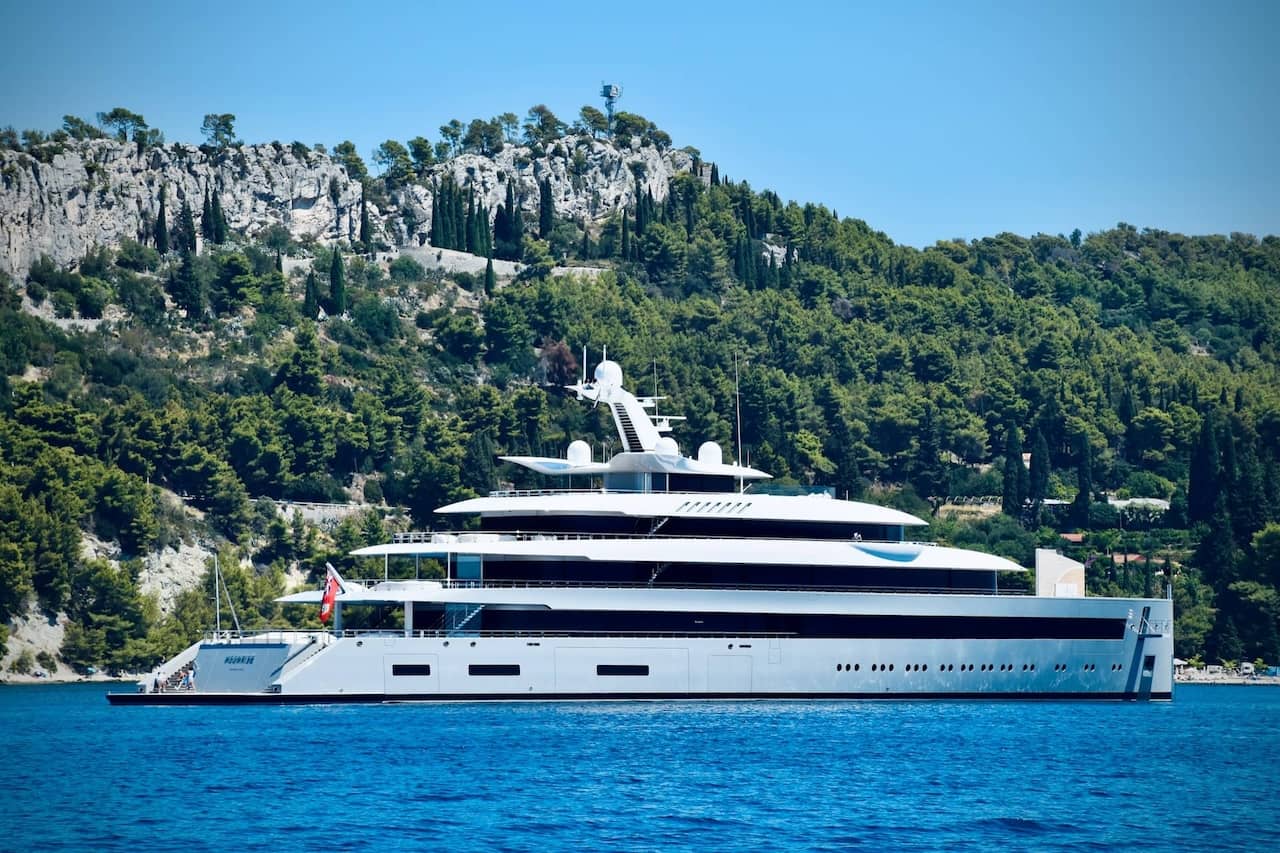
Superyachts are some of the most expensive luxury items on the planet and the largest ones can cost hundreds of millions of dollars.
The Cost of Buying a Superyacht
There are 5,396 superyachts (classified as over 98 feet in length) gracing our oceans as we speak according to SuperYacht Times reporting in 2022. It’s a surprisingly small number when you consider the vast industry that supports them. Although when we look at the cost of owning a superyacht—the build or purchase price , as well as the annual ownership costs—it perhaps shouldn’t come as quite such a surprise. Superyachts are expensive! In fact, they’re one of the most expensive luxury items in the world, and some of the largest superyachts cost not just millions but hundreds of millions to build.
The gargantuan Azzam holds the title of the world’s largest superyacht (for now), and at 590 feet long, it is huge. (See our analysis on Superyacht versus Megayacht .) The industry has estimated it cost $600 million to build, a figure that few people in the world can afford. One of those people is Russian billionaire Roman Abramovich, whose 533-foot superyacht Eclipse cost an estimated $700 million to build in 2009. Jeff Bezos' recently completed the 417-foot superyacht Koru for an estimated $500 million.
While the largest superyachts hit headlines with their jaw-dropping sizes and build prices, the term “superyacht” covers a broad spectrum of sizes, from the smallest 80- to 100-foot (30-meter) yachts straight up to 230-foot yachts (70 meters) and on to those in the 330-foot (100 meter) range. According to Triton Charters, a good rough estimate for a small, custom-built superyacht is $1 million for every 3.3 feet in length. That means a custom 100-footer might cost $30 million. The formula is less likely to work for a larger superyacht, however, such as a 330-footer that could easily have a price tag of $275 million.
When discussing prices it’s important to point out that custom and semi-custom vessels built in a production series hull) superyachts will vary in price accordingly. Many brands such as Princess Yachts or Sunseeker offer a production hull with a range of customizable options, from the layout to the finishings. The specifications chosen may increase the final price 20 percent or more. Even so, a new 130-foot semi-custom superyacht might cost in the region of $12-15 million, less than half what a fully custom yacht would cost due to being built from scratch from the very design upwards.
Pre-owned superyachts of reasonably large size are likely to sell for prices in the $20 to $30 million range, according to a report by Insure4Boats. Older yachts on the market may fetch prices as low as $1.5 million to $2.5 million for a 15- to 20-year-old 90-foot superyacht.
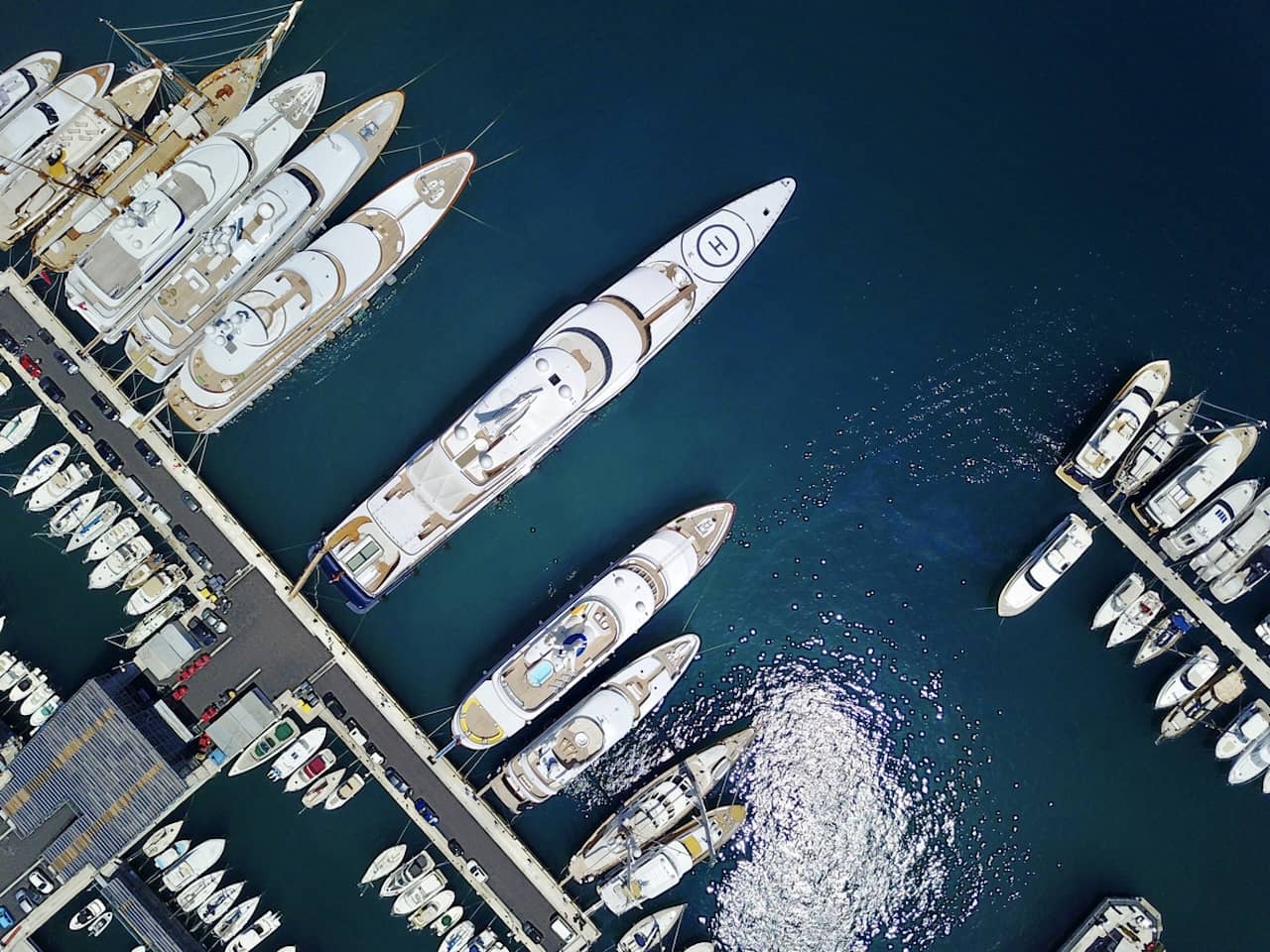
Superyachts vary hugely in size, from 100 feet to the largest at 590 feet in length.
Cost of Owning a Superyacht
Buying a superyacht is one thing, keeping it running is quite another. Where the industry once used the figure of 10 to 12 percent of the price of the boat in running costs per year, today that figure has risen to closer to 20 percent, according to Insure4Boats. So what goes into the running of a boat and why does it cost so much?
As we’ve seen, the sale prices of used yachts vary widely, from $11 million in the 130- to 160-foot category, $24 million in the 160- to 230-foot category, and perhaps $80 million for yachts of 230 feet or more. The running and maintenance costs of any vessel always need to be taken into account when looking at luxury yachts for sale , but when we’re talking superyachts for sale, the figures rise exponentially.
- Fuel: One of the biggest expenses is fuel, as superyachts are thirsty machines. As an example, a 230-foot yacht will use around $2,000 of fuel per hour while underway at 20 knots. A smaller yacht will use much less fuel, so a 150-foot yacht will use around 150 gallons per hour at a rough cost of around $500/hour. Assuming a figure of 500 hours of cruising time a year, that’s a total of $250,000 (excluding all the time spent at anchor with generators running).
- Dockage: Dockage costs for the largest superyachts can be extraodinary, and at any size point they will still be one the biggest expenditures. Prices are based on the length of the yacht per night. The more sought-after and prestigious addresses will carry the largest price tags, with $4,000 per night in the high season commonplace according to the Luxury Yacht Group. Towergate Insurance estimates that docking fees for larger boats can run up to $350,000 per year.
- Crew Salaries: Depending on the size of the superyacht, a full-time crew is usually required, and the size of that crew goes up with the yacht size, ranging from three or four members to in excess of 70 members. From the captain all the way down, the total sum of crew salaries will add up. A comparatively modest 150-foot superyacht could have an annual crew salary of $800,000 according to Luxury Yacht Group, which is around 45 percent of the total annual running costs.
- Maintenance: The upkeep and maintenance of these behemoth yachts is constant and, according to CNN, the annual estimated maintenance costs for Azzam are around $60 million. A much smaller yacht would of course be quite a bit less, but the same yacht maintenance costs need to be factored in. Add to that surveys every few years, which can run into the hundreds of thousands.
- Provisions: Whether the boat is being used by the owner or for charter, there will be a significant cost to provisioning, both for high-profile guests and the crew. Food, alcohol, flowers, water sports equipment, and much more will all be of the highest caliber and run into the hundreds of thousands of dollars. Consider that a single jet ski to run off the back of the yacht can cost between $5,000 and $20,000.
- Insurance and administration: The insurance on a 150-foot yacht would be around $73,000 annually, according to Luxury Yacht Group, with management and administration costs on top of that.

The annual maintenance and running costs of superyachts can run into the millions including crew salaries, fuel, and dockage fees.
How Much Does it Cost to Charter a Superyacht
If the numbers above have got you reassessing whether superyacht ownership is right for you, then fear not. Chartering a superyacht can be a stress-free way to enjoy the luxury yachting lifestyle with more predictable prices. The cost of chartering a yacht will depend on several factors such as the size and age of the yacht, the destination, the length of the charter, and the level of provisioning required.
Superyachts usually operate on a pricing structure that is based on the base cost of chartering the yacht including the crew, facilities, and insurance. Other expenses such as fuel costs, food and drinks, special events, and dockage, which will all vary from charter to charter, are charged in advance in what is known as an Advanced Provisioning Allowance (APA).
According to Northrop and Johnson, superyacht charters can cost anywhere from $150,000 per week to over $2 million per week plus expenses. The 278-foot yacht O’ptasia , for example, has charter prices starting at $868,000, while 196-foot Scott Free starts at £395,000 per week.
Buying a Superyacht
If you think purchasing a superyacht might be right for you some day, read our Top Tips on How to Buy a Superyacht and our article on Superyachts 101: All Your Questions Answered . You can get started by browsing for superyachts for sale and megayachts for sale on Rightboat.
Written By: Samantha Wilson
Samantha Wilson has spent her entire life on and around boats, from tiny sailing dinghies all the way up to superyachts. She writes for many boating and yachting publications, top charter agencies, and some of the largest travel businesses in the industry, combining her knowledge and passion of boating, travel and writing to create topical, useful and engaging content.

More from: Samantha Wilson
Related Articles and Guides
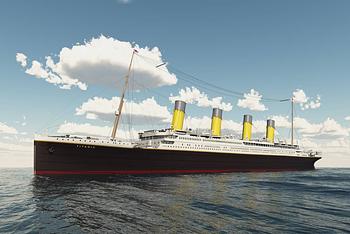
20th May 2024
The Top 10 Famous Classic Ships in History
12th Mar 2024
What Is a Good Boat Name? Over 200 of the Best Boat Names
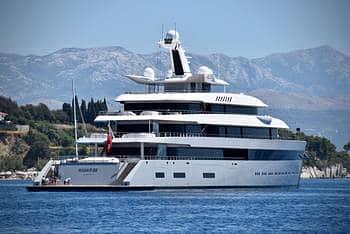
23rd Oct 2023
Yacht Maintenance Cost. The Real Costs of Owning a Superyacht
1st Oct 2023
Fishing in the Gulf of Mexico: Popular Fish To Catch

- Explore Rightboat
- Boats for Sale
- Boating Articles
- Buyers Guide
- About RightBoat
- Sell Your Boat
- Boat Selling Advice
- All manufacturers
- All categories
Enter your email to keep up to date with the latest news
Join for free
Sign up now for free and discover how easy it is to keep up to date with THE latest boats for sale. Find your right boat, and tailor your voyage to finding your next boat.
Benefits of becoming a member:
- Set up tailored alerts
- Personalise your experience
- Download full specifications and broker details
- Keep tabs on your favourite boats
Are you a broker? Join as a Broker
Rightboat - join for free.
Do you have an account already? Login
Save this search
Save your search and receive new boats in your email..
You can unsubscribe from your alerts whenever you like. By pressing the button you accept the Legal Terms and conditions

A GUIDE TO YACHT FUEL: WHAT YOU SHOULD KNOW

Yacht fuel, a vital element for powering watercraft and setting sail into the open waters, plays a crucial role in the maritime industry. Whether you're a seasoned yachtie or a sailing enthusiast, understanding the intricacies of yacht fuel is essential. This article serves as a guide, shedding light on the types of yacht fuel, fuel efficiency, environmental concerns, and more.
What types of yacht fuel are there?
Yachts predominantly rely on two types of fuel - gasoline and diesel.
Gasoline: Typically used in smaller recreational boats and yachts, gasoline is a highly volatile fuel that requires careful handling and storage. It is commonly employed in outboard engines due to its lighter weight and ease of ignition.
Diesel: Larger yachts and commercial vessels usually favor diesel fuel. It offers superior fuel efficiency and is considered safer to handle than gasoline. Diesel-powered yachts are known for their long-range capabilities and lower fuel consumption.
Fuel Tanks and Storage
Yachts are equipped with onboard fuel tanks responsible for storing fuel during voyages. The size of these tanks varies widely depending on the yacht's dimensions, intended use, and range requirements. Proper storage and maintenance of fuel tanks are essential to ensure the safety and efficiency of the vessel.
Fuel Consumption and Efficiency
The fuel consumption of a yacht is influenced by several factors, including:
· Yacht Size and Weight: Larger and heavier yachts typically consume more fuel than their smaller counterparts.
· Engine Type: The type and efficiency of the engines play a significant role in determining fuel consumption.
· Cruising Speed: Operating the yacht at higher speeds can significantly increase fuel consumption.
With environmental concerns becoming more prominent, the yachting industry has seen a surge in efforts to improve fuel efficiency. Manufacturers and designers focus on innovative technologies to reduce emissions and enhance fuel economy, making yachting more sustainable.
Fueling Stations and Prices
Marinas and ports worldwide offer fueling stations where yacht owners can replenish their fuel supply. These fueling facilities cater to both gasoline and diesel-fueled yachts. The prices of yacht fuel can vary based on the location, global oil prices, and local taxes. Many yacht owners plan their journeys strategically, taking into account the availability and cost of fuel at different ports.
Environmental Considerations
The impact of marine vessels, including yachts, on the environment has garnered increased attention in recent years. Emissions from combustion engines, fuel spills, and potential marine life disturbances are among the concerns. As a result, there is growing interest in exploring eco-friendly alternatives to traditional yacht fuel.
In response to these concerns, the yachting industry invests in developing sustainable technologies, such as hybrid propulsion systems, electric motors, and biofuels. The aim is to reduce the carbon footprint and minimize environmental harm while maintaining the luxury of yachting.
What does fuel consumption depend on?
Fuel consumption in various vehicles, including yachts, depends on several factors. The primary factors that influence fuel consumption are as follows:
· Vessel Type and Size: The type and size of the vessel play a significant role in fuel consumption. Larger and heavier vessels typically require more fuel to move and maintain their momentum.
· Engine Efficiency: The efficiency of the engine directly impacts fuel consumption. Modern engines equipped with advanced technologies tend to be more fuel-efficient than older, less sophisticated ones.
· Driving Speed: Fuel consumption increases at higher speeds. Driving at higher velocities requires more energy to overcome air resistance, resulting in higher fuel consumption.
· Load and Cargo: Carrying heavy loads or excessive cargo can cause the engine to work harder, increasing fuel consumption.
· Weather Conditions: Extreme weather conditions, such as very hot or very cold temperatures, can affect fuel consumption. In colder weather, engines might take longer to reach their optimal operating temperature, thus reducing efficiency.
· Maintenance: Regular maintenance, including air filter replacement and engine tune-ups, ensures optimal engine performance and improved fuel efficiency.
· Fuel Type: Different fuel types, such as gasoline and diesel, have varying energy densities, which can affect fuel consumption.
As the yachting industry continues to evolve, embracing environmentally friendly practices and technologies will shape a brighter future for yachting enthusiasts, ensuring that the splendor of sailing is preserved for generations to come.
For further discussion and insights on this topic, check out the Main Deck to engage with other industry professionals and stay informed.
Your source for the latest news on yachts, boats and more. Read through our articles to find out how to compare boats and find the right fit for you!
Measuring your Yacht Fuel Consumption per Hour
Oct 10, 2019
less than a min
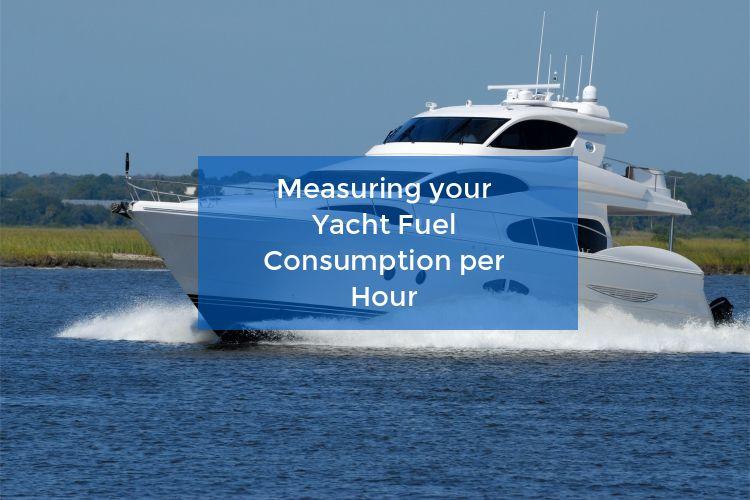
How to measure your yacht fuel consumption per hour
Yachts are quite similar to other vehicles in the sense that they work through fuel. Similarly to any other vehicle, it is important to calculate the yacht fuel consumption per hour before you plan a trip or before you purchase a vessel. Fuel consumption is also a good comparison base between boats. Whether before going on a trip, or buying a yacht, you need to have all the facts straight and know how much money you are going to invest not only at once upon purchase but also periodically.
There are different factors in the fuel consumption of a yacht. For example, if you use a generator or if you stay at anchor instead of docking, the fuel consumption will be increased . The itinerary will change fuel consumption as well. Sea is different than roads and the conditions in a sea change more dramatically than on land, which also impacts fuel consumption.
Fuel consumption for boats is measured in gallons per hour . The efficiency of boat fuel is measured in pounds of fuel that are used in an hour per horsepower. In order to be able to read the calculation right, any boat owner should know that gasoline is almost 6.1 pounds per gallon while diesel is 7.2 pounds per gallon .
Usually, if you consider that all sea conditions are pristine, the fuel consumption of a normal diesel engine is 0.4 pounds per hour for each unit of horsepower.
How to calculate yacht fuel consumption
Calculating it by hand is complicated, which is why many people choose to use online calculators . The way it works is it allows you to put down certain parameters that calculate the fuel consumption. These parameters include route , units of measurement and engine power .
Lastly , what most people are interested in is actually the cost of fuel consumption per hour. So the last parameter to include is the current price of fuel . Marine websites usually include this price up to date.
Another step that people have taken is develop a boat fuel consumption chart for their own boat and find the average in a month.
Alternatively, there is a formula that calculates the maximum fuel consumption of the engine which is:
GPH = (specific fuel consumption x HP) / The specific weight of fuel
This formula determines the fuel consumption when the engine is at full speed . If the speed is decreased then the fuel consumption is decreased as well. Basically, what you need to do is include the horsepower rate of the boat and you multiply it by the specific fuel consumption average and you divide that product by the weight of the fuel.
If you want to compare your boats GPH with other boats than you can use TheBoatDB database. If you already have a boat you can register for free and compare it with other boats within the database.
These are simple methods to calculate fuel consumption, however for a precise one you would have to know all the specifics of your boat and put the parameters through the calculator.
You might like these too

What is a Chine on a Boat lg ...
Oct 01, 2021
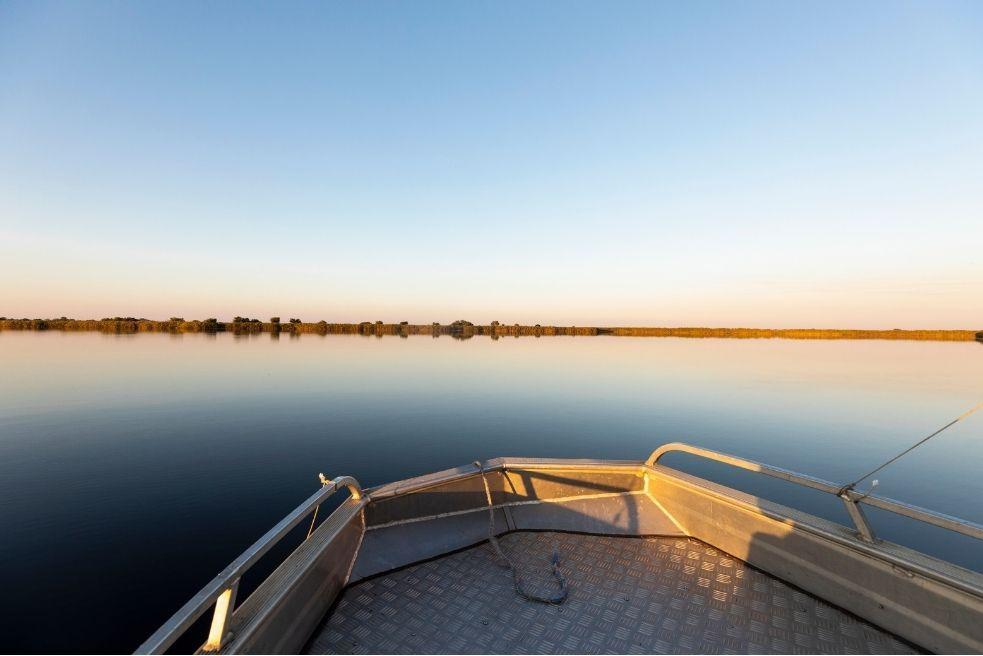
Flat Bottom Boat Advantages lg ...
Sep 30, 2021

Shoal Keel Sailboats Advantages and Disadvantages lg ...
Sep 13, 2021
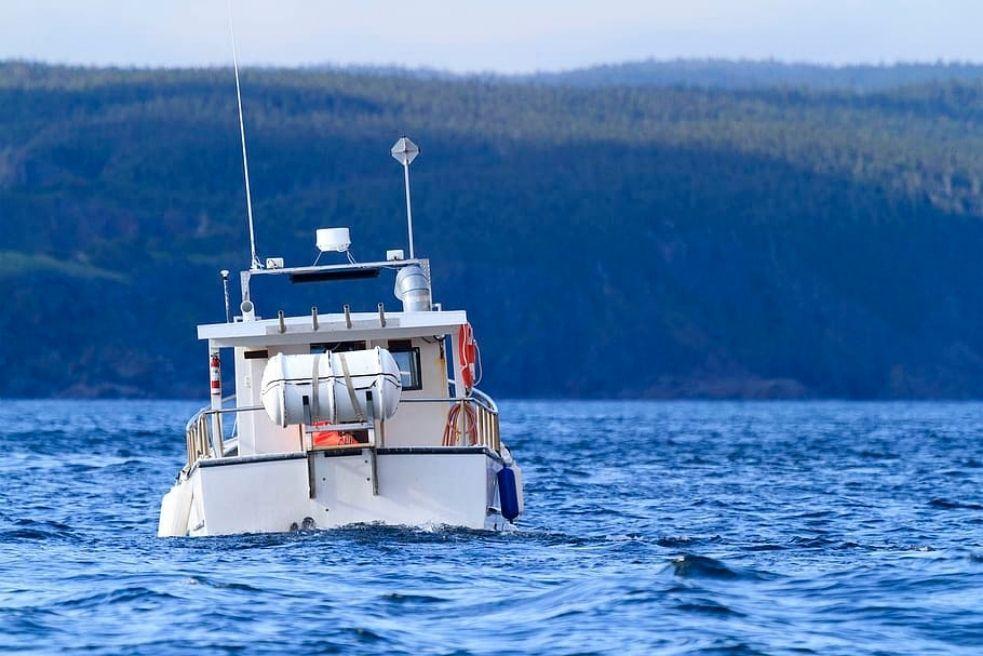
Shallow Draft Boats Explained lg ...
Sep 06, 2021
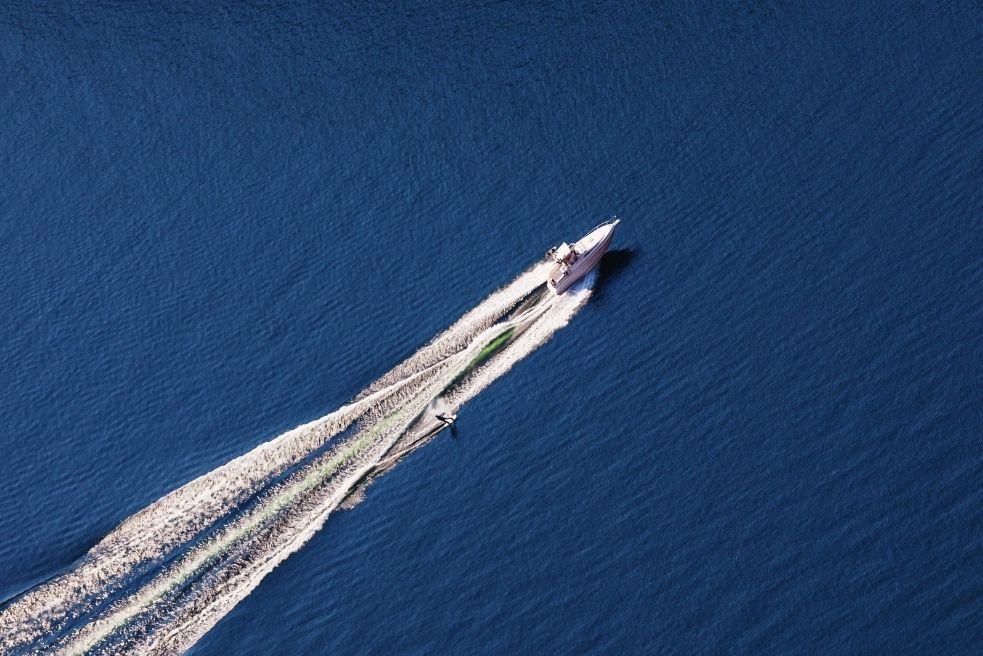
Best Boat for Open Ocean Sailing lg ...
Aug 27, 2021
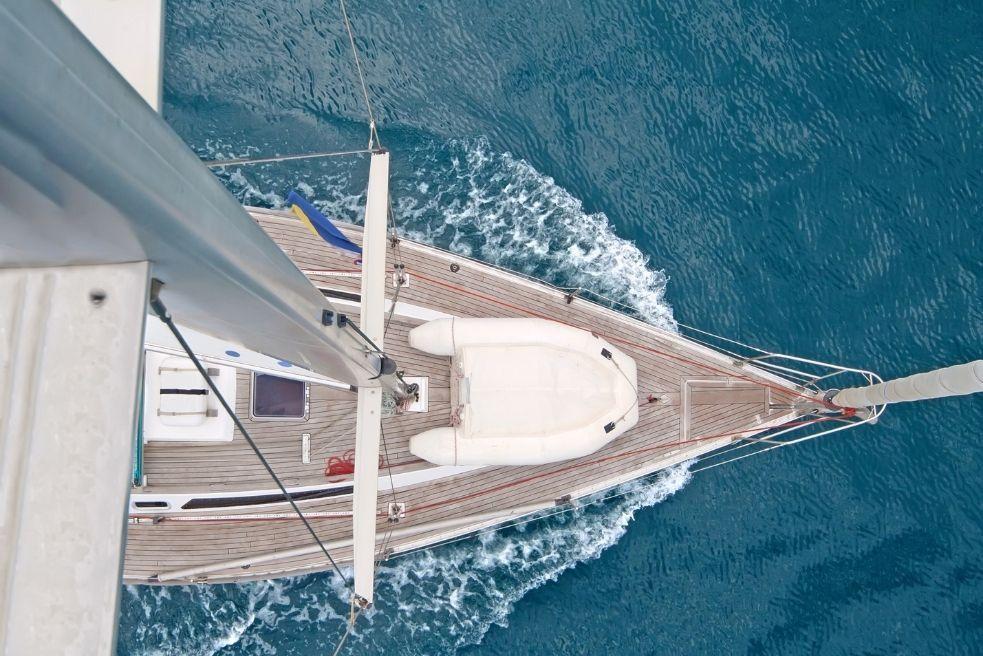
Best Boat Design for Rough Water lg ...
Aug 25, 2021
Please use a modern browser to view this website. Some elements might not work as expected when using Internet Explorer.
- Why Charter Homepage
- Luxury Yacht Vacation Types
- Corporate Yacht Charter
- Tailor Made Vacations
- Luxury Exploration Vacations
- ALL 3,700 Yachts For Charter
- Motor Yachts
- Sailing Yachts
- Classic Yachts
- Catamaran Yachts
- Special Offers
- by Destination
Yacht Reviews
- Destination Guides
- Inspiration & Features
- Mediterranean Charter Yachts
- France Charter Yachts
- Italy Charter Yachts
- Croatia Charter Yachts
- Greece Charter Yachts
- Turkey Charter Yachts
- Bahamas Charter Yachts
- Caribbean Charter Yachts
- Australia Charter Yachts
- Thailand Charter Yachts
- Dubai Charter Yachts
- Destination News
- New To Fleet
- Charter Fleet Updates
- Industry News
- Yacht Shows
- Corporate Charter
- Charter Advice
- Why Use a Yacht Broker
- Charter Costs Explained
- Add my yacht
- Yacht Charter Fleet
- Luxury Yacht Charter Advice
Yacht Charter Costs Explained

A comprehensive breakdown of your charter costs and fees.
When you begin planning a luxury yacht charter it is important to be aware of what is included in the cost of booking your dream charter yacht. although a yacht will have a base charter fee, this may or may not include additional expenses such as food and fuel and this is subject to the terms and conditions within the charter contract. there are various types of charter contracts and which one applies to you will depend on where you wish to cruise., high season.
High season refers to the most popular weeks of the year for yacht charter, whether it’s the winter period in the Caribbean or the height of summer in the Mediterranean , booking in high season requires early planning, determination and a big budget. In addition, planning a yacht charter to coincide with a major event will also be reflected in the price with marine spots for elite events often booking up early. Allow plenty of time when making enquiries to ensure a star studded, well prepared arrival.
Low season typically refers to any time outside of the high season periods. Groups of families and friends looking for a relaxing luxury vacation are advised to avoid high season weeks and opt for weeks outside of this time. The busiest periods are of course reflected in the charter costs and can be up to 15 to 30 percent more expensive than typical low season periods. Chartering a few weeks either side of these busy periods can be almost exactly the same, with the weather almost unchanged in some places, with far less crowds.
Take to our detailed destination guides and browse the yachts available in your chosen destination. Some of the most successful superyachts in the industry can be reserved up to a year in advance and as most yacht brokers will warn away from last minute bookings, it is better to book early and have the pick of the bunch rather than miss out at the last moment. Browse the Events section for details on upcoming festivals and sporting events or visit our Finding a Yacht Broker page to begin your planning your luxury yacht charter.
This article will go into detail of the costs to be expected when planning and booking a yacht charter. From the base charter fee of a yacht, what is covered within the fee and how it may vary in addition to details of contracts and how an Advance Provisioning Allowance (APA) can be used to manage any expenses.
Base Charter Fee
The base charter fee in essence refers to the hire cost of the yacht itself, with all equipment in working order in addition to the cost of food and wages for the crew during the entirety of the charter. This is essentially all the base charter fee covers with additional expenses often applicable on top. The base charter fee will vary from one yacht to another and this may be down to any number of reasons from size and on board amenities to the charter season. For instance, the base rate of a charter yacht may increase in "high season" and reduce during the "low season". "High season" and "low season" refers to the busiest and slowest periods for yacht charters though this may appear misleading, as these peak times refer to periods of weeks as opposed to full seasons. In addition, you may find that a yacht is also more expensive during special events such as the Monaco Grand Prix, Cannes Film Festival and America's Cup. Unless you are keen to charter a yacht for a particular "high season" event, choose your dates carefully as although a "high season" rate will be more expensive than the "low season" the two can sometimes share much of the same weather conditions.
Aside from seasons and events, yachts of the same size may also differ in price and this may be down to a vast difference in on board amenities. A yacht which boasts an on board cinema or lavish water toys may have a higher base rate compared with a yacht of minimal amenities of the same size. If it is unclear as to why two yachts of the same size are vastly different in price, ask your yacht broker to explain what the differences are. Once you are clear on what the base price is and why, it is important to discover what costs will be applicable on top and this is dependent on the type of charter contract used.
The type of charter contract applicable to your charter will depend on where in the world you are cruising, as there are various terms within the industry which dictate how the payment structure is determined. For instance, a MYBA (Worldwide Yachting Association, formerly known as Mediterranean Yacht Brokers Association) contract operates under Western Mediterranean Terms (WMT) and is arguably the most commonly used, particularly with large yachts embarking on a Mediterranean yacht charter. This contract is often referred to as a "plus all expenses" contract and requires that the charterer pay for fuel, food, beverages and dockage fees as an additional expense outside of the base charter fee. Typically, guests can accumulate an additional 25% to 50% of the base charter fee though this is dependent on what is consumed. These expenses can be tracked through the use of an Advance Provisioning Allowance (APA) which we will cover in the next section.
Alternatively, smaller yachts on a Caribbean yacht charter can expect a "mostly all-inclusive" contract known as Caribbean Terms Inclusive (CTI) sometimes referred to as Standard Caribbean Terms (SCT). The Standard Caribbean Terms greatly differ from Western Mediterranean Terms, as the Caribbean terms include three meals a day in addition to four hours cruising per day which is included in the base charter fee.
In addition to the commonly used MYBA terms and Standard Caribbean Terms, there are also less frequently used terms such as Standard Eastern Mediterranean Terms (SEMT) and Greek Terms (GI). Read our guide on Understanding Charter Contracts for more information and if you are unsure as to what is included under the terms of your contract, be sure to ask your broker.
Advance Provisioning Allowance (commonly referred to as APA)
Irrespective of the charter contract it is important for guests to be aware of the Advance Provisioning Allowance (APA). The APA was designed to enable charterers to manage their expenses through a clear and trackable arrangement. An APA is a way to deposit the estimated expense amount of your charter to cover costs such as fuel, food and dockage fees. Typically, the APA accrues to approximately 25% to 30% of the base charter fee, though this does of course depend on the charter parties tastes and requirements and could be far less or far greater than this estimation. For instance, charter guests who intend to regularly dine on caviar and vintage wine can expect to pay more, whereas guests on board a sailing yacht charter can expect to save on fuel costs. Charterers can request an estimated APA amount from the yacht broker based on their on board expectations.
The APA is to be paid approximately one month prior to boarding the charter yacht and is paid directly to the Captain of the yacht. Once the APA has been paid to the captain it will then be retained as a bank account of sorts, from which the captain can make expenditures whilst keeping a record of what has been spent. At any point during the yacht charter guests can request a rundown of accounts from the captain as a way of keeping track of expenditures. The captain will request that any additional funds are paid during the charter should guests exceed the APA. It is therefore a good idea to keep an additional account with your yacht broker on shore, as should the APA become critically low at any time the yacht broker can release additional funds to the captain on the charterers command. Cash can be used if necessary though an on shore account may be deemed as hassle free to some.
It is important to remember that food and fuel for example, are charged at cost without mark up to the charterer and upon disembarking, transactions can be reviewed by the "head" charterer and Captain with any remaining funds to be paid back to the charterer.
Fuel and Dockage Fees
It is important to remember that whilst considering fuel costs, the fuel consumed when using jet-skis and tenders will also apply to the charterer. In addition, whilst docked at a marina the generators used in order to produce electricity will also use fuel. The distance travelled and speed of cruising also affects fuel costs and it is important to bear these factors in mind. Dockage fees may vary from very little to large sums and this is dependent again upon the location and whether you wish to dock during a special event such as the Monaco Grand Prix.
Although insurance costs are not directly connected to the charter costs as such, it is useful to bear in mind should you with to take out Charterers Liability Insurance or Cancellation and Curtailment cover. You can read more information regarding insurance in our How to Book and Plan a Yacht Charter article.
Value Added Tax (VAT)
European Union (EU) tax laws state VAT will apply should you disembark within their waters, for example Italian territorial waters. This may also apply to some Caribbean islands. Commercially registered vessels are usually VAT exempt though vessels which are not commercially registered will be liable for VAT for all charters within the EU.
No request is too large or detail too small on a yacht charter though it is wise to keep in mind the shipping costs should you request an expensive bottle of champagne to be transported to you whilst you are residing in a secluded bay of the Caribbean. It is important to understand the entire payment structure to ensure no unpleasant surprises arise and it is often prudent to keep an escrow account with your broker on shore in order to control charter costs without having to carry cash on board.
Getting Started
- Understanding Charter Costs
- How To Choose Your Yacht
- Finding a Yacht Broker
- Activities On-Board
- Yacht Charter Seasons
- Understanding Charter Contracts
Before You Go
- On Board Etiquette
- What to take on your charter vacation
- Charter Preferences
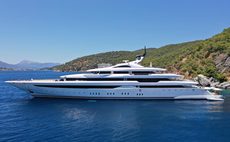
- See All Reviews

From secret hideaways to sought-after hotspots, the Caribbean is..

From upmarket establishments to ramshackle rum shacks, the Carib..
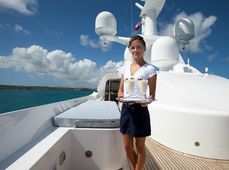
Cocktails and superyachts go hand-in-hand, view ten top choices ..
- See All Top 10
Latest News
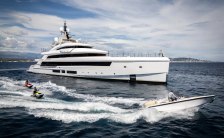
5 September 2024
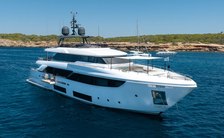
4 September 2024

3 September 2024
- See All News
Upcoming Events

10th - 15th Sep 2024

25th - 28th Sep 2024
- All Upcoming Events
Featured Luxury Yachts for Charter
This is a small selection of the global luxury yacht charter fleet, with 3700 motor yachts, sail yachts, explorer yachts and catamarans to choose from including superyachts and megayachts, the world is your oyster. Why search for your ideal yacht charter vacation anywhere else?

136m | Lurssen
from $3,316,000 p/week ♦︎
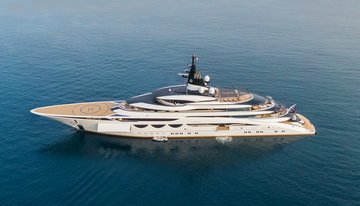
115m | Lurssen
from $2,874,000 p/week ♦︎
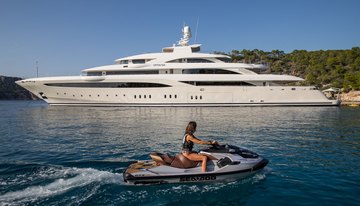
85m | Golden Yachts
from $1,001,000 p/week ♦︎
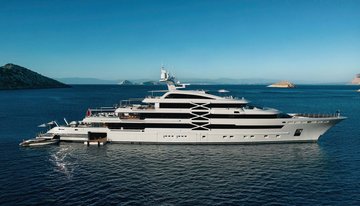
88m | Golden Yachts
from $1,216,000 p/week ♦︎
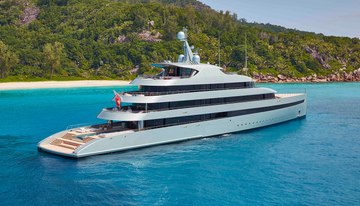
84m | Feadship
from $1,111,000 p/week ♦︎

93m | Feadship
from $1,548,000 p/week ♦︎
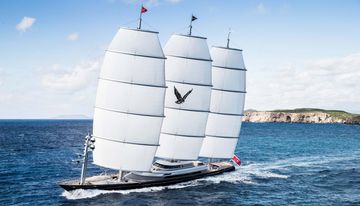
Maltese Falcon
88m | Perini Navi
from $490,000 p/week
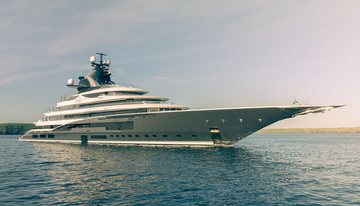
122m | Lurssen
from $3,000,000 p/week
As Featured In
The YachtCharterFleet Difference
YachtCharterFleet makes it easy to find the yacht charter vacation that is right for you. We combine thousands of yacht listings with local destination information, sample itineraries and experiences to deliver the world's most comprehensive yacht charter website.
San Francisco
- Like us on Facebook
- Follow us on X
- Follow us on Instagram
- Find us on LinkedIn
- Add My Yacht
- Affiliates & Partners
Popular Destinations & Events
- St Tropez Yacht Charter
- Monaco Yacht Charter
- St Barts Yacht Charter
- Greece Yacht Charter
- Mykonos Yacht Charter
- Caribbean Yacht Charter
Featured Charter Yachts
- Maltese Falcon Yacht Charter
- Wheels Yacht Charter
- Victorious Yacht Charter
- Andrea Yacht Charter
- Titania Yacht Charter
- Ahpo Yacht Charter
Receive our latest offers, trends and stories direct to your inbox.
Please enter a valid e-mail.
Thanks for subscribing.
Search for Yachts, Destinations, Events, News... everything related to Luxury Yachts for Charter.
Yachts in your shortlist
672 Wine Club
- Motorcycles
- Car of the Month
- Destinations
- Men’s Fashion
- Watch Collector
- Art & Collectibles
- Vacation Homes
- Celebrity Homes
- New Construction
- Home Design
- Electronics
- Fine Dining
- Benchmark Wines
- Brian Fox Art
- Chase United
- Disneyland Resort
- Sports & Leisure
- Health & Wellness
- Best of the Best
- The Ultimate Gift Guide
This Fuel-Sipping Superyacht Can Travel More Than 6,000 Miles Between Fill-Ups
Feadship's new vitruvius-designed 190-foot najiba sets a new standard for superyacht efficiency., howard walker, howard walker's most recent stories.
- Rolls-Royce Debuted the New Phantom Scintilla at Monterey Car Week. Here’s Everything We Know.
- This Speedy 70-Foot Power Catamaran Is Designed to Cut Through Rough Waters
- These Slim New Catamarans Are Redefining the Category. Here’s How.
- Share This Article

Think of it as the Prius of the seas. Najiba , the newly completed, 190-foot all-aluminum superyacht built by Dutch craftsmen at Feadship from a Vitruvius Yachts design, sips fuel like the hybrid Toyota. Well, almost.
During recent sea trials, Najiba reportedly delivered a truly astonishing fuel consumption best of just three gallons per nautical mile at its 12-knot cruising speed. That’s despite this sleek and slender motor yacht tipping the scales at 880 tons and having a couple of muscly 1,448 hp MTU 12-cylinder diesels providing the power.
Luxury Riverboats Are Giving Superyacht Charters a Run for Your Money
- Michael Jordan’s Old Mercedes-Benz SLR McLaren Is Now up for Grabs
- No Joke, California Will Soon Require Your Car to Beep at You if You Speed
The secret, it seems, is down to the highly efficient hull design—that, and a single-minded focus on making the yacht slice through water like a hot knife through butter with minimal resistance.
The creative force behind Vitruvius , ace French designer Philippe Briand —one of his many fortes is drawing super-fast racing sailboats —penned the lines of Najiba’s lightweight alloy hull. He gave the yacht a wave-piercing plumb bow and maximum waterline, and closely worked with Feadship to reduce the effect of appendages like the propeller shafts, stabilizers and thrusters.
The real-world results that came out of the extensive sea trails included an increased top speed—from the original goal of 16 knots to 17—and a cruising-speed range of more than 6,000 nautical miles compared to the projected 5,000 miles. That’s Antibes to Miami with fuel to spare in the yacht’s 23,757-gallon fuel tanks.
The choice of using lightweight aluminum was also a major factor in increasing the yacht’s efficiency. The entire hull and superstructure were built using the alloy, while the yacht’s design called for a sleek, lower-than-usual wheelhouse to reduce wind resistance at speed.
“These results mean that despite the complexity of her development and build, we have outperformed all expectations with Najiba ,” explained Roderick de Vries, technical director of the Feadship yard in Aalsmeer, southwest of Amsterdam.

The entire hull and superstructure were built using lightweight aluminum. Photo: Courtesy of Feadship
“It was a real ‘wow’ moment for everyone involved to see this level of efficiency achieved during sea trials. It is one thing to design such an efficient full-displacement motor yacht, but another to translate these lines and shapes into a stunning Feadship that is even faster and more fuel-efficient than we projected.”

Najiba is the fifth Vitruvius-designed yacht. Photo: Courtesy of Feadship
Right now Najiba , which means “noble,” is with its new owner on a maiden voyage to Bergen in Norway. Chances are he won’t be looking to fill up any time soon.
Read More On:
- Philippe Briand
More Marine

The ‘Titanic”s Iconic Bow Deck Has Partially Fallen Off, an Expedition Finds

Why This Luxe Cruise Ship’s 3-Year World Tour Got Stuck in Belfast Before It Started

Tiara’s Newest 56-Foot, 600 HP Boat Is a Speed Demon in a Full-Feature Package

Meet the Wine Club That Thinks Differently.
Receive editor-curated reds from boutique California producers four times a year.
Give the Gift of Luxury
Latest Galleries in Marine

10 Must-Haves That Will Make Your Yacht Trip Even Better

6 Electric Surfboards That’ll Help You Ride the New E-Foil Wave
More from our brands, louis vuitton’s the hall receives one michelin star in chengdu, china, navarro, pegula highlight billionaire parents at u.s. open, how directors of indie movies like venice’s ‘the brutalist’ have been helped to shoot on film, rabkin foundation names 2024 winners of arts journalism grants, the best yoga mats for any practice, according to instructors.
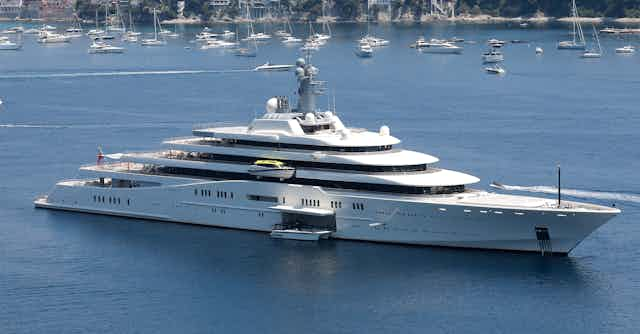
Private planes, mansions and superyachts: What gives billionaires like Musk and Abramovich such a massive carbon footprint
Distinguished Professor and Provost's Professor of Anthropology; Director of the Open Anthropology Institute, Indiana University
Ph.D. Candidate in Anthropology, Indiana University
Disclosure statement
The authors do not work for, consult, own shares in or receive funding from any company or organisation that would benefit from this article, and have disclosed no relevant affiliations beyond their academic appointment.
Indiana University provides funding as a member of The Conversation US.
View all partners
- Bahasa Indonesia
Tesla’s Elon Musk and Amazon’s Jeff Bezos have been vying for the world’s richest person ranking all year after the former’s wealth soared a staggering US$160 billion in 2020, putting him briefly in the top spot .
Musk isn’t alone in seeing a significant increase in wealth during a year of pandemic, recession and death. Altogether, the world’s billionaires saw their wealth surge over $1.9 trillion in 2020, according to Forbes.
Those are astronomical numbers, and it’s hard to get one’s head around them without some context. As anthropologists who study energy and consumer culture, we wanted to examine how all that wealth translated into consumption and the resulting carbon footprint.
Walking in a billionaire’s shoes
We found that billionaires have carbon footprints that can be thousands of times higher than those of average Americans.
The wealthy own yachts, planes and multiple mansions, all of which contribute greenhouse gases to the atmosphere. For example, a superyacht with a permanent crew, helicopter pad, submarines and pools emits about 7,020 tons of CO2 a year, according to our calculations, making it by the far worst asset to own from an environmental standpoint. Transportation and real estate make up the lion’s share of most people’s carbon footprint, so we focused on calculating those categories for each billionaire.

To pick a sample of billionaires, we started with the 2020 Forbes List of 2,095 billionaires. A random or representatives sample of billionaire carbon footprints is impossible because most wealthy people shy away from publicity , so we had to focus on those whose consumption is public knowledge. This excluded most of the superrich in Asia and the Middle East .
We combed 82 databases of public records to document billionaires’ houses, vehicles, aircraft and yachts. After an exhaustive search, we started with 20 well-known billionaires whose possessions we were able to ascertain, while trying to include some diversity in gender and geography. We have submitted our paper for peer review but plan to continue adding to our list.
We then used a wide range of sources, such as the U.S. Energy Information Administration and Carbon Footprint , to estimate the annual CO2 emissions of each house, aircraft, vehicle and yacht. In some cases we had to estimate the size of houses from satellite images or photos and the use of private aircraft and yachts by searching the popular press and drawing on other studies . Our results are based on analyzing typical use of each asset given its size and everything else we could learn.
We did not try to calculate each asset’s “ embodied carbon ” emissions – that is, how much CO2 is burned throughout the supply chain in making the product – or the emissions produced by their family, household employees or entourage. We also didn’t include the emissions of companies of which they own part or all, because that would have added another significant degree of complexity. For example, we didn’t calculate the emissions of Tesla or Amazon when calculating Musk’s or Bezos’ footprints.
In other words, these are all likely conservative estimates of how much they emit.
Your carbon footprint
To get a sense of perspective, let’s start with the carbon footprint of the average person.
Residents of the U.S., including billionaires, emitted about 15 tons of CO2 per person in 2018. The global average footprint is smaller, at just about 5 tons per person.
In contrast, the 20 people in our sample contributed an average of about 8,190 tons of CO2 in 2018. But some produced far more greenhouse gases than others.
The jet-setting billionaire
Roman Abramovich, who made most of his $19 billion fortune trading oil and gas, was the biggest polluter on our list. Outside of Russia, he is probably best known as the headline-grabbing owner of London’s Chelsea Football Club.

Abramovich cruises the Mediterranean in his superyacht, named the Eclipse , which at 162.5 meters bow to stern is the second-biggest in the world, rivaling some cruise ships. And he hops the globe on a custom-designed Boeing 767 , which boasts a 30-seat dining room. He takes shorter trips in his Gulfstream G650 jet, one of his two helicopters or the submarine on his yacht.
He maintains homes in many countries, including a mansion in London’s Kensington Park Gardens, a chateau in Cap D’Antibes in France and a 28-hectare estate in St. Barts that once belonged to David Rockefeller . In 2018, he left the U.K. and settled in Israel , where he became a dual citizen and bought a home in 2020 for $64.5 million.
We estimate that he was responsible for at least 33,859 metric tons of CO2 emissions in 2018 – more than two-thirds from his yacht, which is always ready to use at a moment’s notice year-round.
Massive mansions and private jets
Bill Gates, currently the world’s fourth-richest person with $124 billion, is a “modest” polluter – by billionaire standards – and is typical of those who may not own a giant yacht but make up for it with private jets.

Co-founder of Microsoft, he retired in 2020 to manage the Bill and Melinda Gates Foundation, the world’s largest charity, with an endowment of $50 billion.
In the 1990s, Gates built Xanadu – named after the vast fictional estate in Orson Welles’ “Citizen Kane” – at a cost of $127 million in Medina, Washington. The giant home covers 6,131 square meters, with a 23-car garage, a 20-person cinema and 24 bathrooms. He also owns at least five other dwellings in Southern California, the San Juan Islands in Washington state, North Salem, New York, and New York City, as well as a horse farm , four private jets, a seaplane and “a collection” of helicopters .
We estimated his annual footprint at 7,493 metric tons of carbon, mostly from a lot of flying.
The environmentally minded tech CEO
South African-born Elon Musk, CEO of Tesla Motors and SpaceX, has a surprisingly low carbon footprint despite being the world’s second-richest person, with $177 billion – and he seems intent on setting an example for other billionaires .

He doesn’t own a superyacht and says he doesn’t even take vacations .
We calculated a relatively modest carbon footprint for him in 2018, thanks to his eight houses and one private jet. This year, his carbon footprint would be even lower because in 2020 he sold all of his houses and promised to divest the rest of his worldly possessions .
While his personal carbon footprint is still hundreds of times higher than that of an average person, he demonstrates that the superrich still have choices to make and can indeed lower their environmental impact if they so choose.
His estimated footprint from the assets we looked at was 2,084 tons in 2018.

The value of naming and shaming
The aim of our ongoing research is to get people to think about the environmental burden of wealth.
While plenty of research has shown that rich countries and wealthy people produce far more than their share of greenhouse gas emissions, these studies can feel abstract and academic, making it harder to change this behavior.
[ Like what you’ve read? Want more? Sign up for The Conversation’s daily newsletter .]
We believe “shaming” – for lack of a better word – superrich people for their energy-intensive spending habits can have an important impact, revealing them as models of overconsumption that people shouldn’t emulate.
Newspapers, cities and local residents made an impact during the California droughts of 2014 and 2015 by “drought shaming” celebrities and others who were wasting water, seen in their continually green lawns . And the Swedes came up with a new term – “ flygskam ” or flying shame – to raise awareness about the climate impact of air travel.
Climate experts say that to have any hope of limiting global warming to 1.5 degrees Celsius above preindustrial levels, countries must cut their emissions in half by 2030 and eliminate them by 2050.
Asking average Americans to adopt less carbon-intensive lifestyles to achieve this goal can be galling and ineffective when it would take about 550 of their lifetimes to equal the carbon footprint of the average billionaire on our list.
- Climate change
- Carbon emissions
- Carbon footprint
- Paris Agreement
- Billionaires
- Roman Abramovich

Research Fellow in Coastal Numerical Modelling

Director of STEM

Community member - Training Delivery and Development Committee (Volunteer part-time)

Chief Executive Officer

Head of Evidence to Action
Ever wondered how much it costs to fuel a $600 million superyacht? Hint – For that money, you can actually get an apartment in Manhattan and a Tesla Model S.
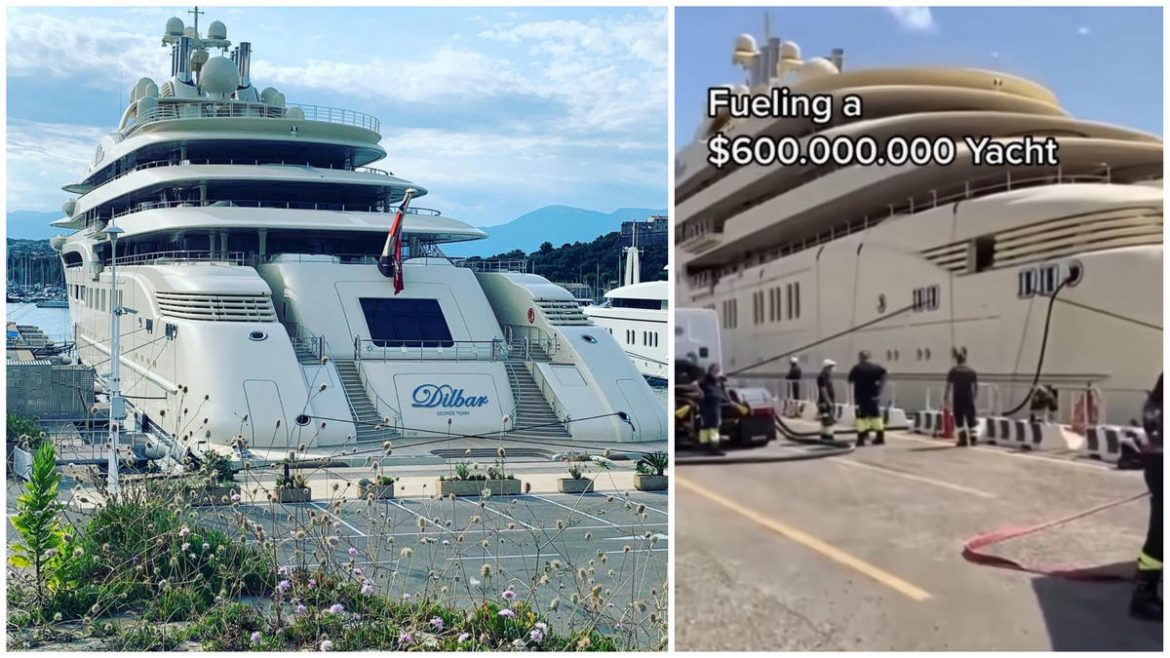
The things we associate with superyachts – size, grandeur, and billionaires; but never bills! If buying a megayacht is a big feat, then maintaining the behemoth deserves a trophy too. Many world-renowned superyachts cost hundreds of millions (Dilbar is worth $600 million), but have you ever wondered how much it costs to get these floating beasts of the seas from one point to another? Dilbar yacht is considered one of the largest yachts in the world in volume. It was record-breaking owing to its incredible technology and the sheer size and was launched by German shipyard Lürssen in 2016. The fourth-longest yacht in the world that can house a crew of a hundred people also flaunts a total fuel capacity of 1,000,049 liters. By comparison, the Airbus A380 which is the worlds largest commercial aircraft needs 372,800 liters of fuel to tank up.
View this post on Instagram A post shared by Denis S (@theyachtmogul)
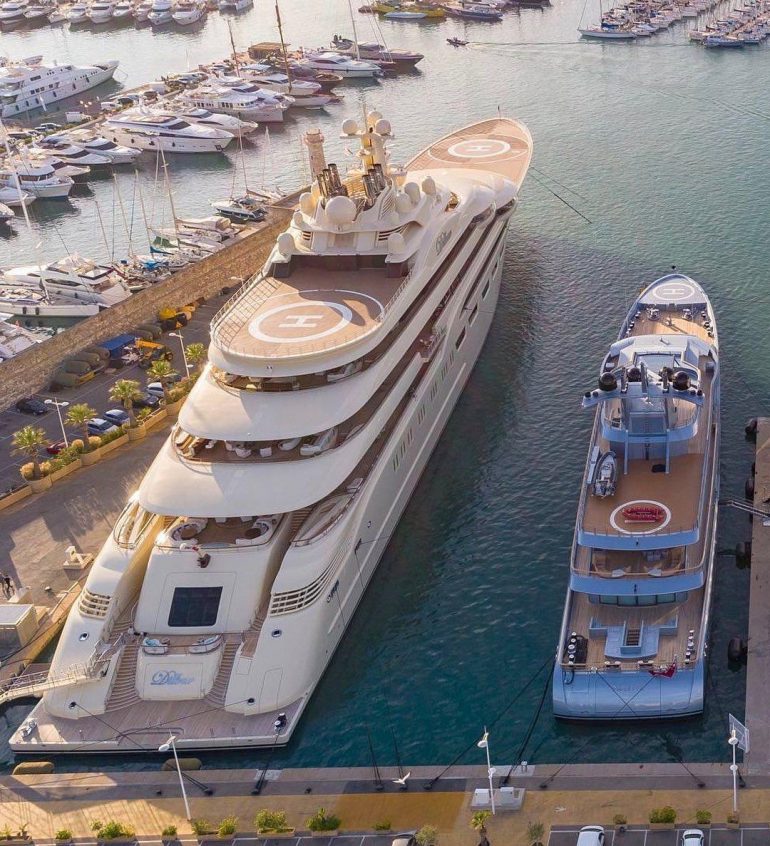
Note – The price of a Tesla Model S is $89,000 and a 690 sq ft 1 bhk apartment in 25, Broad Street, NYC costs $760,000.

You may also like

The Black belt billionaire sheikh who manages a trillion dollar fund has converted a Russian research vessel into his personal 410 feet long ultra-luxury superyacht. The $250 million ‘Maryah’ accommodates 54 guests, has a massive night club, business centre and even a sushi bar.

Tom Cruise, while vacationing on a 263 feet long superyacht, spotted a burning yacht. The real-life hero immediately sailed toward it and rescued the five victims just as their vessel sank into the Mediterranean waters.

Despite turning off the location transponders and sailing in secrecy, Mark Zuckerberg’s $300 million superyacht and its bright red helicopter caused a sensation in Mallorca. Now, the privacy-loving Facebook founder is moving his superyachts to a secret location in the Mediterranean.
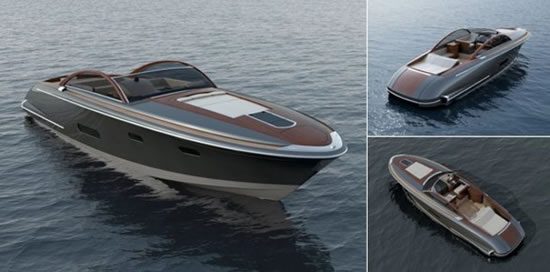
Vicem unveils the Vanguard line of Superyacht Tenders
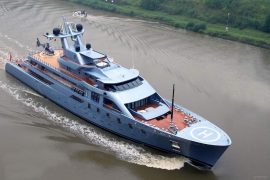
To avoid being seized by the authorities, this Russian billionaire rushed his $150 million color-changing megayacht to Panama. Equally mysterious and luxurious, the 280-feet vessel is one of the fastest in its class it has two helipads, a large swimming pool, and a full-fledged gym.
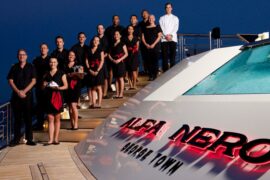
After 18 grueling months, the crew of the abandoned Alfa Nero and its sister superyacht, the Luminosity—both allegedly owned by sanctioned billionaire Andrey Guryev—will receive their pre-sanction salaries.

Time-lapse video shows the Jacksonville Jaguars owner’s 400-foot-long Kismet superyacht being built from scratch
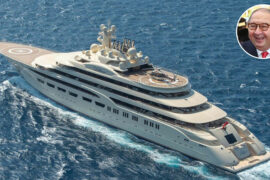
Sanctioned oligarch and early Facebook investor Alisher Usmanov scores another victory, with a German court ruling for the return of confiscated assets, including a $5 million artwork, that were seized from his $600 million megayacht and vacation homes.
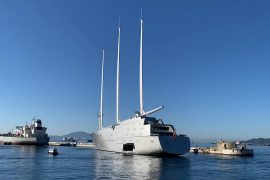
Impounded last year, the sanctioned Russian billionaire’s $580 million megayacht has become a big headache for the Italian government. 470 feet long and the world’s largest sailing yacht, it requires special care and is costing the authorities $900,000 a month in upkeep alone.

How Much Fuel Does a Boat Use Per Hour? A Comprehensive Guide
Boating enthusiasts and boat owners alike often wonder how much fuel their boat uses per hour.
The answer to the question of how much fuel does a boat use is not straightforward, as fuel consumption can vary depending on several factors. Boat size, weight, engine type, and speed are just a few examples of the variables that can affect fuel usage.
Understanding how much fuel a boat uses per hour is crucial for boaters who want to plan their trips and budget accordingly. Furthermore, knowing how to calculate fuel consumption can help boaters make informed decisions when shopping for a new boat or engine.

In this article, we will explore the factors that influence fuel consumption in boats and provide tips on how to estimate fuel usage. By the end of this article, readers will have a better understanding of how much fuel their boat uses per hour and how to optimize their fuel consumption.
Understanding Fuel Consumption in Boats
Boat fuel consumption can vary significantly depending on various factors. Understanding these factors is crucial to estimate how much fuel a boat will consume in a given period. This section will discuss some of the critical factors that affect fuel consumption and how to calculate it.
Factors Affecting Fuel Consumption
- Boat Type and Size: The type and size of the boat have a significant impact on fuel consumption. Smaller boats tend to consume less fuel than larger boats. For example, a 20-foot boat will consume less fuel than a 40-foot boat with the same engine.
- Engine Type and Size: The type and size of the engine also play a crucial role in fuel consumption. A larger engine will consume more fuel than a smaller engine, even if both are of the same type. Gasoline engines tend to consume more fuel than diesel engines.
- Weight: The weight of the boat and its load can affect fuel consumption. A heavier boat will require more fuel to move than a lighter boat.
- Speed: The speed at which the boat is traveling can significantly impact fuel consumption. Boats that travel at higher speeds tend to consume more fuel than boats that travel at lower speeds.
- Weather and Water Conditions: Weather and water conditions can affect fuel consumption. Boats traveling against the tide or in rough water will consume more fuel than boats traveling with the tide or in calm water.
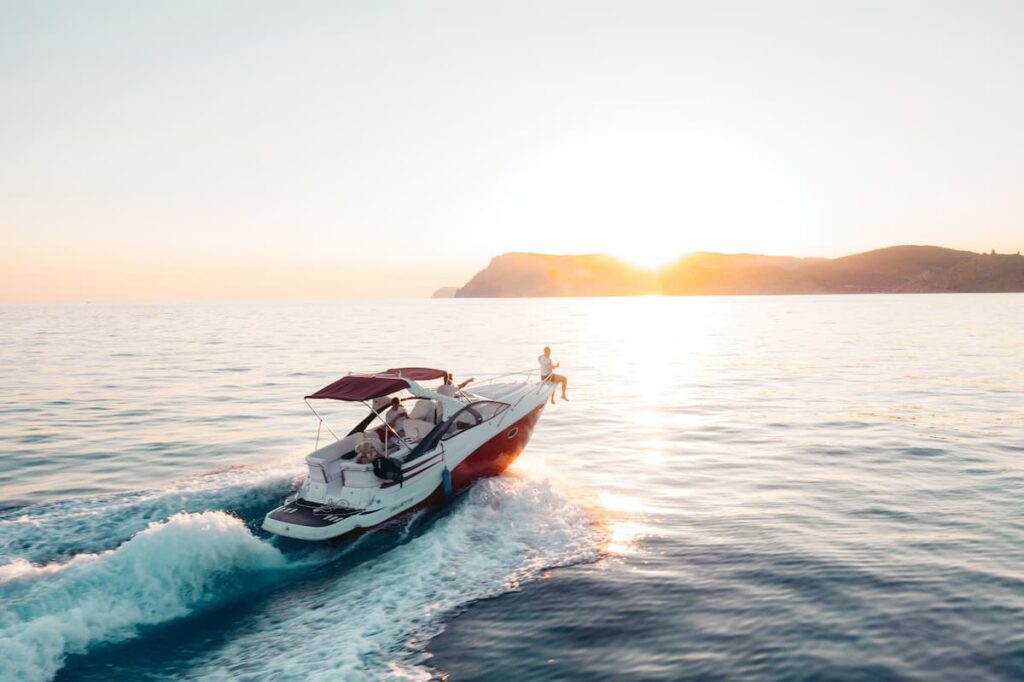
Calculating How Much Fuel Does a Boat Use Per Hour
To calculate fuel consumption, you need to know the fuel burn rate of the engine. The fuel burn rate is the amount of fuel the engine consumes per hour. You can calculate the fuel burn rate by dividing the engine’s horsepower by the fuel consumption rate.
For example, if an engine has a horsepower of 100 and consumes 10 gallons of fuel per hour, the fuel burn rate would be 10/100, which is 0.1 gallons per horsepower per hour.
Once you know the fuel burn rate, you can estimate how much fuel the boat will consume in a given period. For example, if the boat travels at a speed of 20 knots and has a fuel burn rate of 0.1 gallons per horsepower per hour, and the engine has 200 horsepower, the boat will consume 20 gallons of fuel per hour.
In conclusion, understanding fuel consumption in boats requires knowledge of several critical factors, including boat type and size, engine type and size, weight, speed, and weather and water conditions. Calculating fuel consumption involves determining the fuel burn rate of the engine and estimating how much fuel the boat will consume in a given period.
Types of Boats and Their Fuel Consumption
When it comes to fuel consumption, different types of boats have different requirements. Factors such as the boat’s size, weight, and speed all play a role in determining how much fuel it will consume per hour. Here are some common types of boats and their typical fuel consumption rates.
Fishing Boats
Fishing boats are typically smaller and slower than other types of boats, which means they use less fuel. On average, a fishing boat will use between 3 and 8 gallons of fuel per hour at cruising speed.
Pontoon Boats
Pontoon boats are popular for leisurely cruising and entertaining. They are larger than fishing boats and have a flat bottom, which makes them more stable. However, this also means they use more fuel. A pontoon boat will typically use between 5 and 15 gallons of fuel per hour at cruising speed.
Bass boats are designed for fishing and are typically smaller and faster than other types of boats. They are also more fuel-efficient, using between 3 and 6 gallons of fuel per hour at cruising speed.
Center Console Boats
Center console boats are versatile and can be used for fishing, cruising, and water sports. They are larger than bass boats and typically use between 10 and 20 gallons of fuel per hour at cruising speed.
Cabin Cruiser Boats
Cabin cruiser boats are designed for overnight trips and have a cabin with sleeping quarters and a bathroom. They are larger and heavier than other types of boats, which means they use more fuel. A cabin cruiser boat will typically use between 20 and 30 gallons of fuel per hour at cruising speed.
Bowrider Boats
Bowrider boats are popular for water sports and leisurely cruising. They are typically smaller than cabin cruiser boats but larger than fishing boats. A bowrider boat will typically use between 5 and 15 gallons of fuel per hour at cruising speed.
Overall, the fuel consumption of a boat depends on various factors such as boat size, weight, and speed. Understanding the fuel consumption of different types of boats can help you make an informed decision when choosing a boat that meets your needs while minimizing your fuel costs.
Engine Size and Power
Understanding horsepower.
When it comes to boat engines, horsepower is a crucial factor in determining how much fuel a boat will consume per hour. Horsepower is a measure of the engine’s power output, and it directly affects the speed and performance of the boat. The more horsepower an engine has, the faster the boat will go, but it will also consume more fuel.
How Engine Size Affects Fuel Consumption
Another important factor that affects fuel consumption is the engine size. The size of the engine is measured in horsepower, and it can range from small outboard motors with 9.9 hp to large inboard engines with over 300 hp. In general, larger engines consume more fuel than smaller engines, but they also provide more power and speed.
The type of engine is also important when it comes to fuel consumption. Two-stroke engines are known to be less fuel efficient than four-stroke engines, but they are also lighter and provide more power. Four-stroke engines, on the other hand, are more fuel efficient and produce less emissions , but they are heavier and provide less power.
The weight of the boat and the drag created by the hull also play a role in fuel consumption. Heavier boats require more power to move through the water, which means they will consume more fuel. Boats with a sleek, streamlined hull design will create less drag and require less power to move through the water, resulting in lower fuel consumption.
Here is a table that shows the average fuel consumption for different engine sizes:
| Engine Size | Fuel Consumption (Gallons per Hour) |
|---|---|
| 9.9 hp | 0.5 – 1.5 |
| 15 hp | 0.75 – 2 |
| 20 hp | 1 – 3 |
| 25 hp | 1.5 – 3.5 |
| 40 hp | 2.5 – 6 |
| 50 hp | 3 – 7 |
| 60 hp | 3.5 – 8 |
| 75 hp | 4 – 10 |
| 90 hp | 5 – 12 |
| 115 hp | 6 – 15 |
| 175 hp | 10 – 25 |
| 200 hp | 12 – 30 |
| 225 hp | 14 – 35 |
| 250 hp | 16 – 40 |
| 20 – 50 |
It’s important to note that these numbers are just averages, and actual fuel consumption will depend on a variety of factors, including boat weight , hull design, and weather conditions.
Cruising Speed and Fuel Efficiency
Understanding cruising speed.
Cruising speed is the speed at which a boat travels comfortably and efficiently. It is important to understand that cruising speeds vary depending on the type of boat, weather conditions, water conditions, and the number of passengers on board. In general, most boats have a cruising speed of around 20-30 knots.
When a boat is traveling at its cruising speed, it is operating at its most efficient fuel consumption rate. Going faster than the cruising speed can result in a significant increase in fuel consumption. On the other hand, going slower than the cruising speed can also result in increased fuel consumption as the boat struggles to maintain speed.
How to Optimize Fuel Efficiency
To optimize fuel efficiency, it is important to find the ideal cruising speed for your boat. This can be done by conducting a fuel consumption test. Take a piece of paper and make a table, or use a spreadsheet, listing out the rpm, speed in mph, and amount of fuel burned per hour, or gph. Divide the speed by the gph, and you’ll get mpg.
To further optimize fuel efficiency, consider the following tips:
- Reduce weight on board: The more weight on board, the more fuel the boat will consume. Remove any unnecessary items to reduce weight.
- Maintain the boat: A well-maintained boat will operate more efficiently and consume less fuel.
- Adjust trim: Adjusting the trim of the boat can help reduce drag and increase fuel efficiency.
- Monitor weather and water conditions: Rough weather and choppy waters can cause the boat to consume more fuel. Avoid these conditions when possible.
In conclusion, understanding cruising speed and optimizing fuel efficiency can help reduce fuel consumption and save money. Conducting a fuel consumption test and following these tips can help you find the ideal cruising speed for your boat and reduce fuel consumption.
Fuel Costs and Maintenance
Boat ownership comes with a set of responsibilities that extend beyond simply enjoying the water. One of the most significant factors to consider is the cost of fuel and maintenance.
Calculating Fuel Costs
Fuel costs are a significant expense for boat owners, and calculating them can be challenging. The amount of fuel a boat uses per hour depends on several factors, including the size and weight of the vessel, the type of engine, and the speed at which it is traveling.
Boat owners can use a fuel consumption calculator to estimate how much fuel their vessel will consume based on these factors. It is important to remember that fuel prices can vary depending on the marina and the type of fuel used.
Fuel-Efficient Boats
Fuel-efficient boats are becoming increasingly popular among boat owners due to the cost savings they offer. These boats are designed with fuel efficiency in mind and typically have smaller engines that consume less fuel.
Boat owners can also take steps to make their vessels more fuel-efficient, such as reducing their speed, maintaining their engines, and properly inflating their tires.
Maintenance Tips
Proper maintenance is crucial for keeping a boat in good working condition and minimizing fuel costs. Boat owners should regularly inspect their vessels for any signs of wear and tear and address any issues promptly.
Regular engine maintenance, such as oil changes and filter replacements, can also help improve fuel efficiency and reduce the risk of breakdowns. Boat owners should also ensure that their boats are properly cleaned and stored to prevent damage from the elements.
In conclusion, fuel costs and maintenance are significant expenses for boat owners to consider. By calculating fuel costs, investing in fuel-efficient boats, and practicing proper maintenance, boat owners can minimize their expenses and enjoy their vessels for years to come.

Frequently Asked Questions
What is the average fuel consumption for a boat per hour.
The average fuel consumption for a boat per hour varies depending on several factors such as the size and type of the boat, the engine’s horsepower, and the speed at which the boat is traveling. As a general rule of thumb, a small boat with a 25-horsepower engine can consume around 2-3 gallons of fuel per hour, while a larger boat with a 200-horsepower engine can consume around 20-30 gallons of fuel per hour.
How do I calculate fuel usage for a boat trip?
To calculate fuel usage for a boat trip, you need to know the boat’s fuel consumption rate, the distance to be covered, and the speed at which you will be traveling. You can use an online fuel consumption calculator or a fuel flow meter to determine the boat’s fuel consumption rate. Once you have this information, you can estimate how much fuel you will need for your trip.
What is the fuel efficiency of a 26-foot boat?
The fuel efficiency of a 26-foot boat depends on several factors such as the boat’s weight, the engine’s horsepower, and the speed at which the boat is traveling. On average, a 26-foot boat with a 250-horsepower engine can consume around 20-25 gallons of fuel per hour at cruising speed.
How much fuel does a 50-foot boat use per hour?
The amount of fuel a 50-foot boat uses per hour depends on several factors such as the boat’s weight, the engine’s horsepower, and the speed at which the boat is traveling. On average, a 50-foot boat with a 500-horsepower engine can consume around 50-60 gallons of fuel per hour at cruising speed.
How much diesel fuel is consumed per horsepower?
On average, a diesel engine consumes around 0.4 pounds of fuel per hour for each unit of horsepower it produces. For example, a 200-horsepower diesel engine would consume around 80 pounds of fuel per hour.
How far can a boat travel on a full tank of gas?
The distance a boat can travel on a full tank of gas depends on several factors such as the boat’s fuel consumption rate, the size of the fuel tank, and the speed at which the boat is traveling. On average, a boat can travel around 100-200 miles on a full tank of gas. However, this can vary significantly depending on the boat’s size, weight, and engine horsepower.
- Recent Posts
- The Role of Cargo Ships in Global Trade – August 22, 2024
- Report: Yang Ming’s YM Mobility Explosion at Ningbo-Zhoushan Port – August 9, 2024
- Understanding Drillships: Types, Key Features and Advancements – August 1, 2024
About the author
I worked as an officer in the deck department on various types of vessels, including oil and chemical tankers, LPG carriers, and even reefer and TSHD in the early years. Currently employed as Marine Surveyor carrying cargo, draft, bunker, and warranty survey.
Latest posts

The Quality Control Process in Marine Manufacturing
Companies in the marine manufacturing space must have tight and effective quality control processes. What steps should an effective quality control process include?

The Role of Cargo Ships in Global Trade
Contents show Volume of Goods Transported by Sea Key Global Trade Routes Economic Impact of Maritime Shipping Types of Cargo Commonly Transported Environmental Considerations Conclusion Cargo ships are the lifeline […]

What Are AGVs? Automation Becoming Increasingly Common in Seaports
What are AGVs? Automated guided vehicles can minimize the troubles of manual operations and enhance seaport operations.
Boat Reviews
- Boats Specs
- Marine Pros
- Boat Insurance
- Boat Warranties
- Boat Transport
- Boat Towing
- Marine Forecasts

Your Ultimate Boating Resource

What is the fuel capacity of a yacht?
Yachts are one of the most popular types of boats out there. They come in all sorts of sizes, from small sailboats to massive motor yachts. One of the most important things to consider when buying a yacht is fuel capacity. How much fuel can the yacht hold, and what kind of range can you expect?
The fuel capacity of a yacht depends on a few different factors. First of all, the size of the yacht plays a big role. Bigger yachts generally have larger fuel tanks, which means better range and longer trips. However, there are many smaller yachts that have impressive fuel capacities as well.
Another important factor to consider is the type of yacht. Sailboats, for example, usually have smaller fuel tanks than motor yachts. This is because sailboats rely on wind power to move, while motor yachts need fuel to power their engines. However, newer sailboats often have engines for auxiliary power, so their fuel tanks are bigger than they used to be.
When it comes to the actual fuel capacity of a yacht, it varies widely. Smaller yachts might have fuel tanks that hold just a few dozen gallons, while larger yachts can hold thousands of gallons. The fuel capacity of a yacht is often related to how far the yacht can travel on one tank of fuel. This is known as “range.”
The range of a yacht depends on many factors, including the size of the fuel tank, the efficiency of the engines, and the speed at which the yacht is traveling. A larger fuel tank usually means a longer range, but if the engines are not very efficient, the range might not be much longer than a smaller yacht with more efficient engines.
In general, a 50-foot yacht might have a fuel capacity of around 500-1,000 gallons, while a 100-foot yacht could have a fuel capacity of 5,000 gallons or more. Again, these numbers vary widely depending on the specific yacht in question.
Fuel capacity is a critical consideration for yacht owners. Knowing how much fuel your yacht can hold, and how far you can travel on that fuel, is essential for planning longer trips or navigating to more remote destinations. When buying a yacht, it’s important to make sure the fuel capacity meets your needs, so you can enjoy all the adventures that come with owning a yacht.
Related Questions
What type of wood is used for pier pilings, what is the difference between a dock and a floating pier, what is the proper technique for pulling a beginner wakeboarder, what does ‘no wake’ mean on a lake, what is the difference between wash and wake, is wakesurfing possible in the sea, why don’t wooden piers rot, what size wakeboard is needed, how to achieve more pop on a wakeboard, does wake surfing translate to ocean surfing, latest posts, overview of the 2024 sea-doo rxp-x 325, overview of the 2024 parker offshore 2900 cc, what your boat’s beam is and why it matters, power cats of 2024: ultimate guide to the top power catamarans this year, don't miss, our newsletter.
Get the latest boating tips, fishing resources and featured products in your email from BoatingWorld.com!
Navigating the Heat: 10 Safety Tips for a Safe Boat Ride in the Summer Heat
Highs, lows, and tidal know-how: a deep dive into ocean currents, 10 essential tips for fishing near private property, the benefits of using a drift sock: guidance for anglers, lure fishing: secrets for imitating live bait and attracting fish, explore the untapped depths of america’s best bass fishing spots, outboard motor maintenance: tips for keeping your engine in top shape, the essential boat tool kit: tools every boater needs, diy boat building: 8 tips and tricks for building your own vessel, the art of miniature maritime craftsmanship: ship in a bottle, antifouling paints: a guide to keeping your boat shipshape, beginner’s guide to standup paddle boarding: tips and techniques, boating for fitness: how to stay active on the water, kayak safety: how to stay safe on the water, anchoring in a kayak or canoe: how to secure your small boat, overview of the 2024 yamaha 252sd, overview of the 2024 tiara yachts 48 le, overview of the 2024 bass cat jaguar sts, 2024 pursuit os 445: an overview, 2024 aquila 47 molokai review, 2024 sea-doo switch 13 sport review, gear reviews, megabass oneten max lbo jerkbait review, fortress anchors fx-7 anchoring system review, fortress anchors fx-11 anchoring system review, fortress anchors commando anchor kit review, fortress anchors aluminum anchors review, stay in touch.
To be updated with all the latest news, offers and special announcements.
- Privacy Policy
Cost of Buying & Owning a Small Yacht (Detailed Breakdown)
While some people may prioritize a slower, more eco-friendly, and more hands-on experience that they get from a sailing yacht, others may prefer a faster, more luxurious, but less hands-on experience from operating a motor yacht. However, the tiebreaker comes down to the costs of owning and maintaining them. With that, let's explore how much you'll need to buy and own either a small sailing yacht or a motor yacht, and see which one is more affordable.
A new 30-foot sailing yacht can cost anywhere from $50,000 to $200,000, while a used one in good condition can range from $20,000 to $100,000. On the other hand, a new 30-foot motor yacht can cost between $100,000 and $500,000, while a used one can range from $50,000 to $300,000.
The ongoing costs of owning a yacht include maintenance and repair costs, fuel costs, insurance, docking fees, and more. Let's take a closer look at each of these costs and how they can impact your budget.
- The initial purchase price and ongoing costs of owning a motor yacht are higher than those of a sailing yacht.
- A sailing yacht relies mostly on wind power, while motor yachts require more complex mechanical systems and need more fuel.
- Purchasing older yachts may require more maintenance and repairs.
- Additional initial expenses when purchasing a used yacht include hiring a surveyor, buying bottom paint, looking for upgrades, and purchasing safety equipment.
- Insurance costs for motor yachts are higher due to their faster speeds and increased risk of accidents.
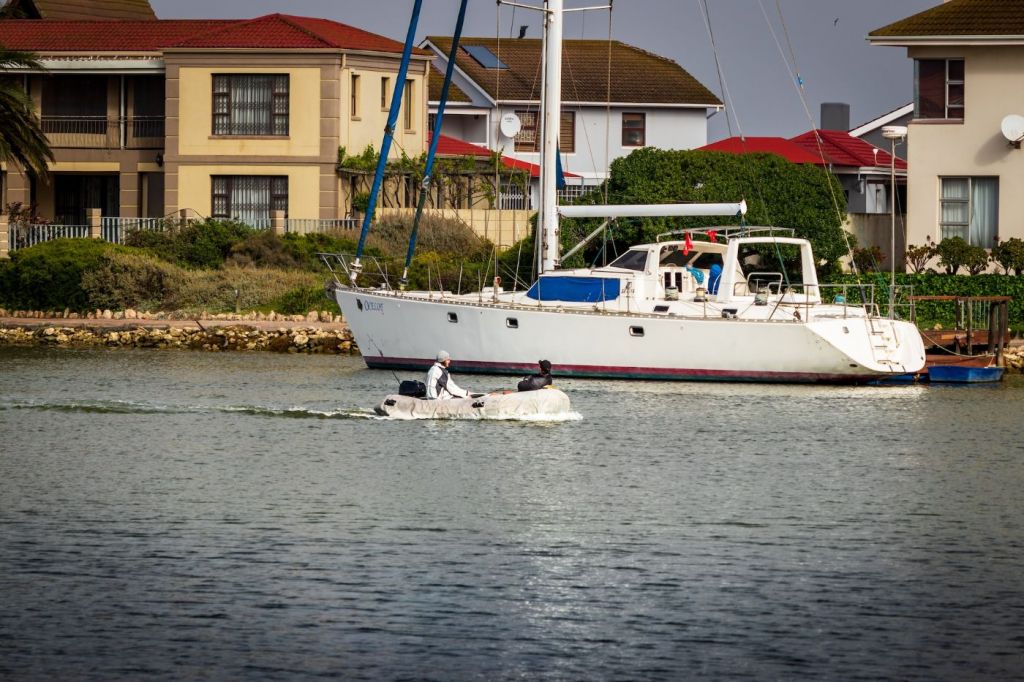
Cost of Buying And Owning A Small Yacht
| $54,750 - $216,750 | $10,300 - $42,400 | |
| $23,500 - $121,500+ | $3,200 - $20,500+ | |
| $108,050 - $540,750 | $9,500 - $57,500 | |
| $55,000 - $328,500 | $12,000 - $28,000 |
1. The average cost of owning a new 30-foot sailing yacht
On average, a small brand-new sailing yacht can cost anywhere from $50,000 to $200,000 or more. This price range typically includes basic features like a cabin, galley, and bathroom, as well as a mast, sails, and rigging. However, the price may not include additional amenities like a generator, air conditioning, or advanced navigation systems.
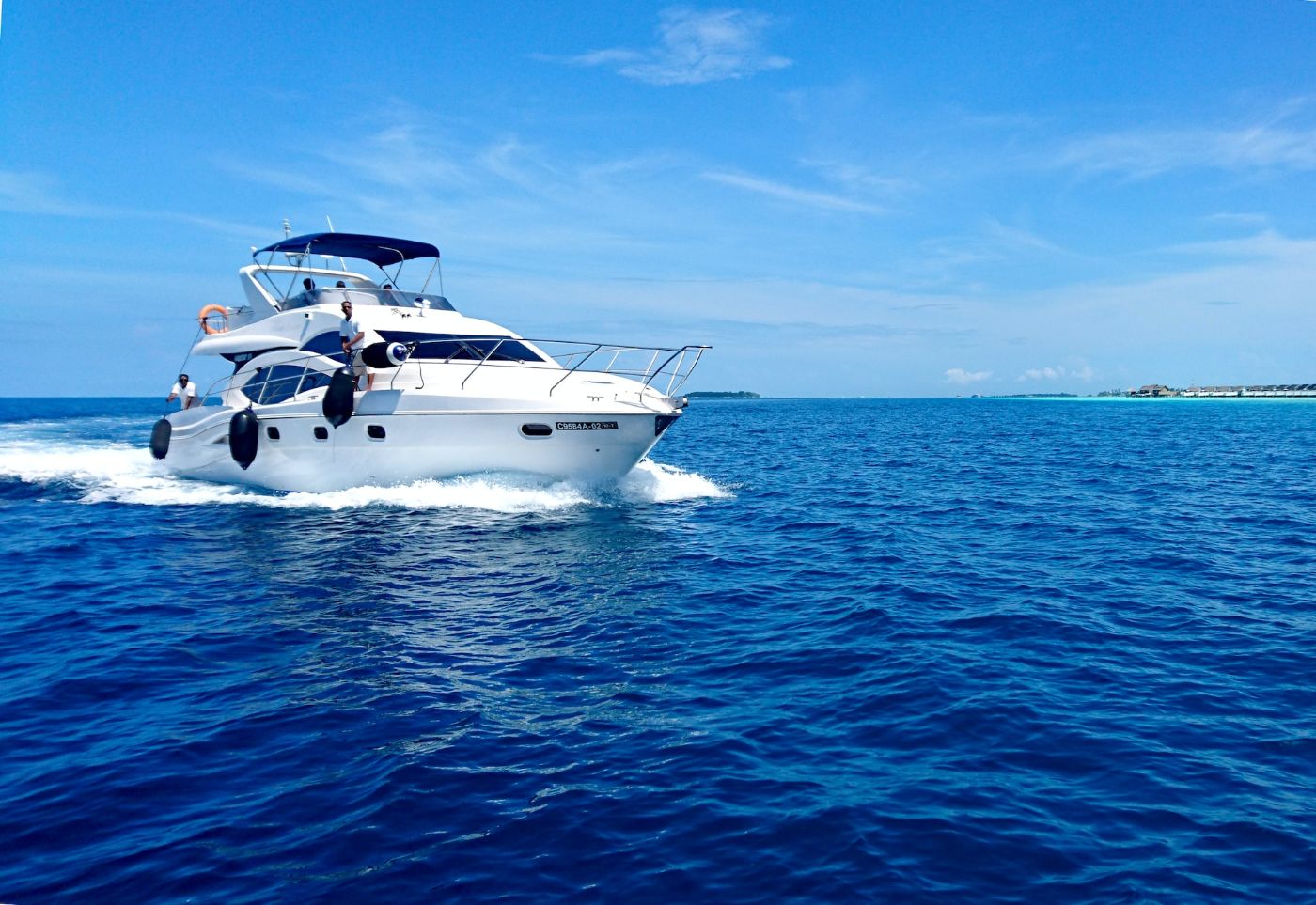
In addition to the initial purchase price, there are also ongoing costs associated with owning a sailing yacht, such as mooring fees, maintenance and repairs, insurance, and fuel costs. These expenses can add up quickly, and you may need to factor them into your budget when considering buying a sailing yacht.
One advantage of owning a sailing yacht is that it can be less expensive to operate than a power yacht, as it relies on wind power rather than fuel. However, sailing yachts also require more maintenance and upkeep, particularly for the rigging and sails .
Initial expenses for a new 30-foot sailing yacht
| $50,000 - $200,000 | |
| $500 | |
| $4,000 - $16,000 | |
| $250 | |
Recurring expenses for a new 30-foot sailing yacht
| $3,600 - $18,000 | |
| $500 - $2,000 | |
| $5,000 - $20,000 | |
| $1,200 - $2,400 | |
2. The average cost of owning a used 30-foot sailing yacht
In general, you can expect to pay anywhere from $20,000 to $100,000 for a used 30-foot sailing yacht. This cost will typically include the purchase price of the boat itself, as well as any necessary upgrades or repairs that may be required.
Once you have purchased the boat, there are a number of ongoing costs associated with owning and maintaining it. These can include mooring or slip fees, insurance, registration and licensing fees, and regular maintenance and repairs.
Although used sailing yachts can be much more affordable than new ones, they may require more maintenance and repairs which can be costly and time-consuming. There may be hidden issues or problems with a used boat that are not immediately apparent, which can lead to unexpected expenses down the line.
Initial expenses for a used 30-foot sailing yacht
| $20,000 - $100,000 | |
| $500 - $1,500 | |
| $1,000 - $3,000 | |
| $500 - $5,000 | |
| $500 - $1,500 | |
| $1,000 - $10,000+ | |
Recurring expenses for a used 30-foot sailing yacht
| $500 - $2,000 | |
| $1,200 - $12,000 | |
| $1,000 - $5,000 | |
| $500 - $1,500 | |
3. The average cost of owning a new 30-foot motor yacht
The cost of a new 30-foot motor yacht can range from around $100,000 to over $500,000, with some luxury models costing even more. Although operating a motor yacht requires less skill and experience than operating a sailing yacht, the initial purchase price and ongoing costs are higher than that of a sailing yacht.
This is because motor yachts require more complex mechanical systems, such as engines, generators, and other electrical and plumbing systems, which can be expensive to install and maintain. They also need more fuel than sailing yachts, which can result in higher ongoing costs for fuel and maintenance.
Initial expenses for a new 30-foot motor yacht
| $100,000 - $500,000 | |
| $7,500 - $37,500 | |
| $50 - $250 | |
| $500 - $2,500 | |
Recurring expenses for a new 30-foot motor yacht
| $3,000 - $25,000 | |
| $1,500 - $7,500 | |
| $2,000 - $10,000 | |
| $3,000 - $15,000 | |
4. The average cost of owning a used 30-foot motor yacht
A used 30-foot motor yacht can cost anywhere from $50,000 to $300,000 or more. However, you'll need to note that older yachts may require more maintenance and repairs, which can add to the overall cost of ownership.
It can be difficult to know how these yachts were used and maintained by their previous owner, which can lead to unexpected issues and repairs. They may also have less fuel-efficient engines, which can lead to higher fuel costs over time.
Initial expenses for a used 30-foot motor yacht
| $50,000 to $300,000 | |
| $500 - $3,000 | |
| $1,000 - $6,000 | |
| $1,500 - $7,500 | |
| $500 - $3,000 | |
| $1,500 - $9,000 | |
Recurring expenses for a used 30-foot motor yacht
| $1,500 - $3,000 | |
| $3,000 - $10,000 | |
| $2,500 - $5,000 | |
| $5,000 - $10,000 | |
Expenses Involved In Buying and Owning A Small Yacht

Initial expenses in buying a small yacht
Boat purchase is not cheap.
The first cost you'll encounter when buying a yacht is the purchase price which can range from tens of thousands of dollars to millions of dollars. When setting a budget for your yacht purchase, try to consider not only the purchase price but also the ongoing costs of ownership.
You need to register your yacht
Before you can legally operate your small yacht, you need to register it with the relevant authorities. The registration process depends on your location and the size of your yacht. In Oregon, for example, all boats with motors must be titled and registered with the Oregon State Marine Board. The registration fee is based on the length of the vessel.
To register your yacht, you will need to provide proof of ownership, such as a bill of sale, and complete the necessary paperwork. You may also need to provide proof of insurance and pay any applicable taxes.
Factor in payment for taxes
Each state has its own tax laws, and some states may have additional taxes or fees that apply to yacht owners. In Florida, there is a 6% sales tax on boats, while in Texas, the sales tax is 6.25%. In addition to state taxes, some municipalities or counties may also charge a local sales tax.
Set aside payment for the title fee
The title fee is the cost of transferring the ownership of the yacht from the seller to the buyer. The title fee for a small yacht can range from a few hundred dollars to a few thousand dollars.
Budget for hiring a surveyor
A survey is particularly important when buying a used boat, as it can help uncover any hidden problems that may not be immediately apparent to the buyer. Used boats can have a range of issues, from minor cosmetic defects to serious structural damage, and a survey can help to identify these issues before the sale is completed.
During the survey, the marine surveyor will thoroughly inspect the boat's hull, deck, and superstructure, as well as its mechanical systems, electrical systems, and safety equipment. The surveyor will also test the boat's performance on the water, including its handling, speed, and maneuverability.
After the survey is complete, the surveyor will provide the buyer with a detailed report of their findings, including any defects or deficiencies that were identified. This report can be used by the buyer to negotiate the purchase price or to request that any necessary repairs be made before the sale is completed.
Used small yachts need upgrades and customizations
One of the joys of yacht ownership is the ability to customize your vessel to suit your needs and preferences. Some common upgrades and customizations include:
- Deck hardware: Installing new hardware such as cleats, winches, and blocks can improve the functionality of your yacht, but can also be expensive.
- Communications: Upgrading your communication systems, such as radios and satellite phones, can improve safety and convenience, but can also be costly.
- Vinyls: Adding vinyl graphics to your yacht can be a fun way to personalize your vessel, but can also be expensive.
- Anti-fouling paint: Applying anti-fouling paint to the bottom of your yacht can help prevent the growth of marine organisms, but can also be a recurring expense.
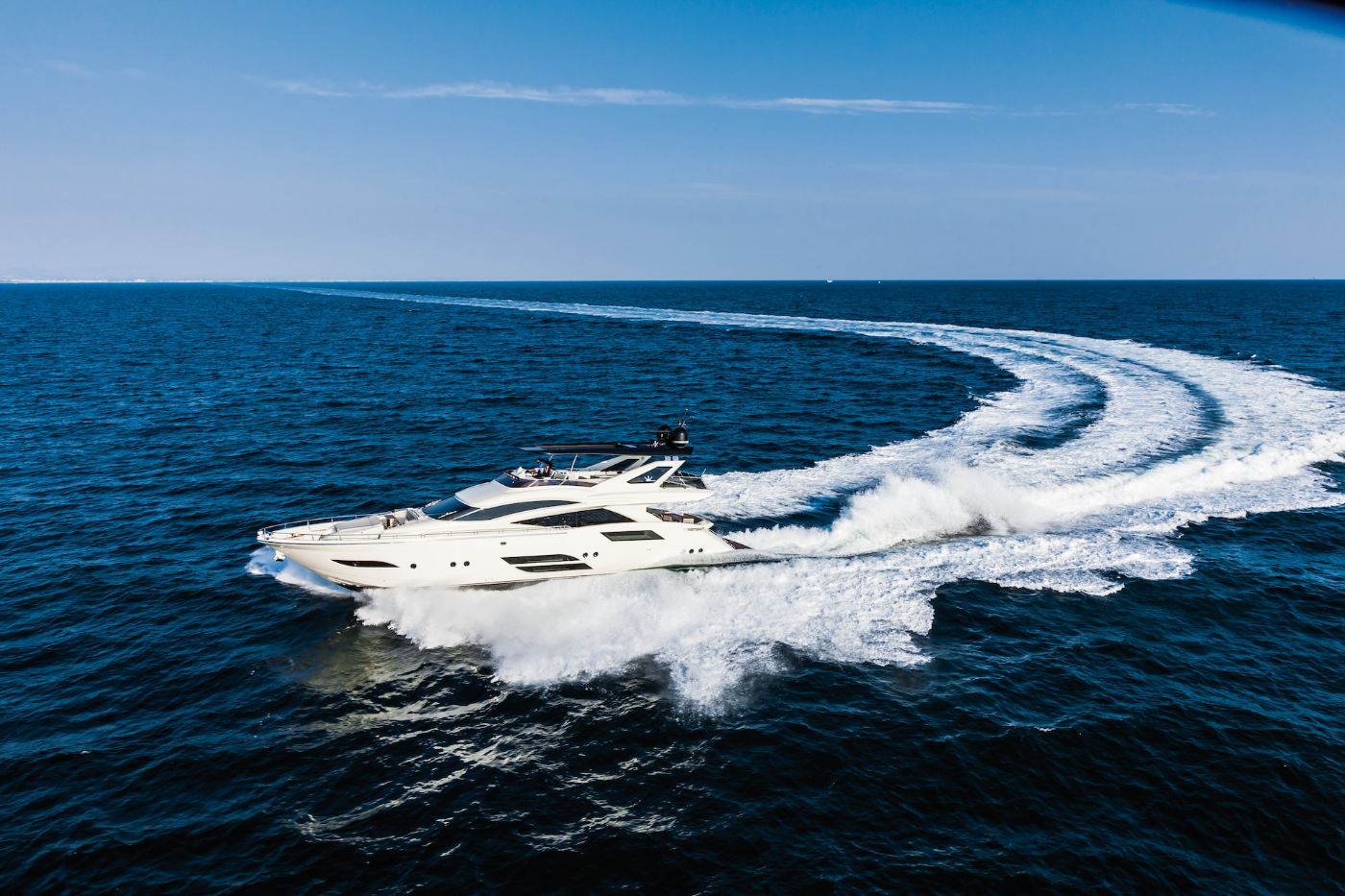
Consider the costs of buying safety equipment
Safety should always be a top priority when operating a yacht. Some essential safety equipment includes:
- Life jackets: Having enough properly fitting life jackets for all passengers is essential for safety.
- Fire extinguishers: Having properly functioning fire extinguishers on board can help prevent a disaster.
- First aid kit: Having a well-stocked first aid kit on board can help in case of injury or illness.
- Emergency signaling devices: Having emergency signaling devices such as flares or an EPIRB can help alert others in case of emergency.
For a more detailed list of the safety equipment you need for your newly purchased small yacht, here's an article you can refer to.
Recurring costs for owning a small yacht
In addition to the initial expenses, there are also ongoing costs associated with owning a yacht such as the following:
Avail an insurance policy for your yacht
Shop around for insurance agencies that specialize in yachts, as there are many clauses and catchphrases that are unfamiliar to the average insurance agent. Insurance companies that specialize in boats often provide surprising discounts for both your own skills and the equipment on your boat.
A specialized insurance policy is generally estimated at between 0.8% and 1.2% of the boat's purchase price per year. It should also cover these 10 basic things included in this article.
Sailing yachts may be more expensive to insure due to their increased risk of damage from weather and other environmental factors, while motor yachts may be more expensive due to their higher speeds and increased risk of accidents.
Keep in mind dockage and mooring fees
You can save money on docking fees by anchoring in free anchorages or finding marinas that offer discounts for long-term stays. Some marinas charge by the foot, while others charge a flat rate. You can try to research different marinas in your area to find the best deal.
In addition to the basic fee, some marinas charge extra for amenities such as electricity, water, and Wi-Fi. You may also want to consider the location of the marina since marinas in popular tourist destinations tend to be more expensive than those in less popular locations.
If you're in California, here are 7 places where you can dock your yacht at the cheapest price.
Consider costs for maintenance and repairs
Maintaining and repairing your small yacht is an important part of yacht ownership. Regular maintenance ensures that your yacht is safe to operate, and it can prevent costly repairs down the line.
Routine maintenance is the regular upkeep of your yacht, which includes things like cleaning, oil changes, and checking the engine and other systems. Consider following the manufacturer's guidelines for routine maintenance, as this will help prevent breakdowns and keep your yacht in good condition.
Now, even with regular maintenance, repairs may be necessary from time to time. Repairs can range from minor fixes like replacing a lightbulb to major repairs like fixing a damaged hull. Address repairs as soon as possible to prevent further damage.
For bottom paint, you can read this article on How Much Does it Cost to Antifoul a Boat? (Bottom Paint)
Account for fuel costs
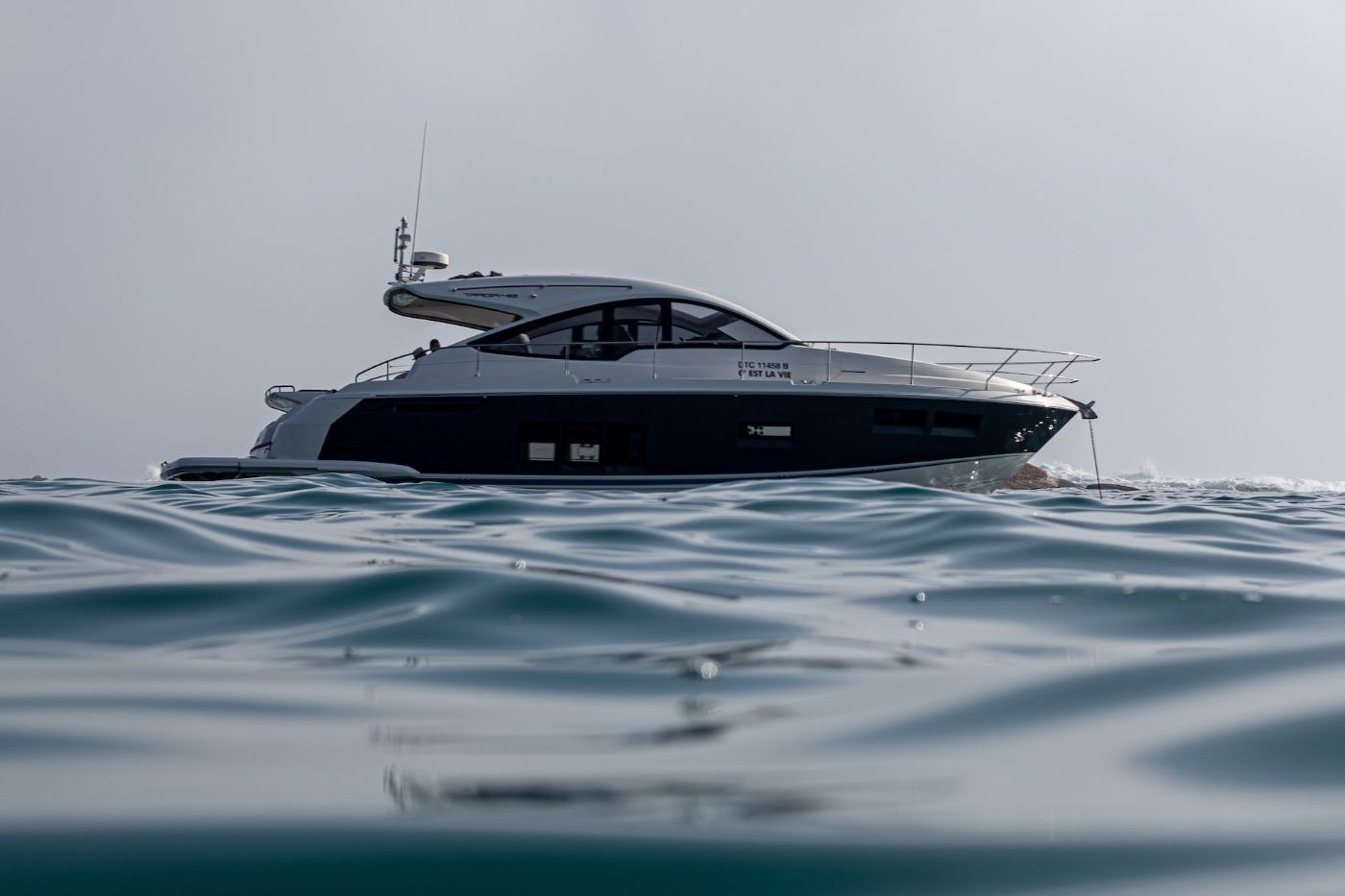
The type of yacht you own will determine the fuel you use. For example, a motor yacht will require more fuel than a sailing yacht. Fuel costs are usually calculated per gallon. You can use a yacht fuel cost calculator to estimate how much fuel you will need for your trip and the approximate cost.
You can save money on fuel costs by filling up at a marina that offers fuel at a lower price. You might also want to consider using fuel additives that can improve your yacht's fuel efficiency and reduce fuel consumption.
Leave a comment
You may also like, how much sailboats cost on average (380+ prices compared).
Turns out that owning a sailboat is pretty affordable. OK, it isn't cheap, but it can absolutely be done on a budget. In this article, I'll show you exactly what to …

Average Cost of Buying & Owning a Catamaran (With 4 Examples)

The Average Cost of Owning a Boat in Florida (4 Examples)

Average Sailboat Insurance Cost in 2023 (13 Examples)
- Pontoon Boats
- Personal Watercraft
- nauticalknowhow
- Nautical Knots
- Tools and Calculators
Bill Gates Yacht: Everything You Want To Know
In 2020 the yachting world was abuzz with news that Bill Gates had bought as stunning and advanced yacht known as Project Aqua. The massive, 370-foot concept yacht was revealed in 2019 at the Monaco Yacht Show and news soon followed that billionaire Bill Gates, once the richest man in the world and the founder of Microsoft, had commissioned the construction of his own hydrogen-powered Aqua. But that never actually happened and, in fact, as near as anyone can tell for real, Bill Gates doesn’t own a yacht at all.
So where did the story come from? What’s the deal with the Aqua? And hasn’t Bill Gates been pictured on a yacht before? Let’s get some answers.
How Much Did the Aqua Yacht Cost at the Monaco Yacht Show?
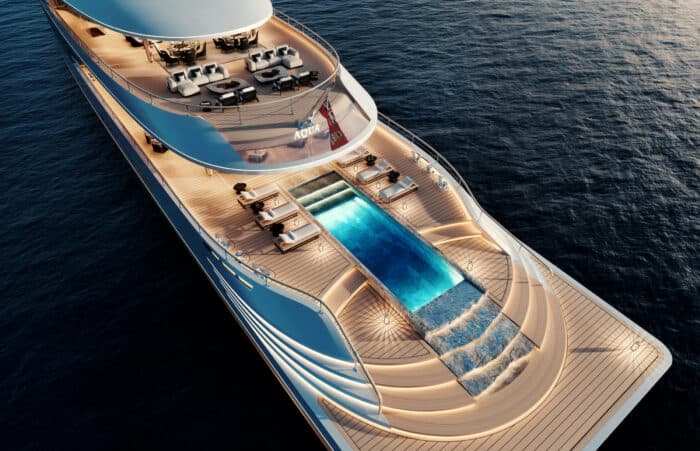
According to the stories online, Bill Gates paid $600 million for the hydrogen powered yacht. But that’s not true at all. According to the yacht makers, the Dutch company Sinot, the price tag is $645 million but no one bought it after it was revealed at the Monaco Yacht Show, and that includes Bill Gates. It’s expensive but definitely not the most expensive in the world.
How Fast is the Aqua Yacht?
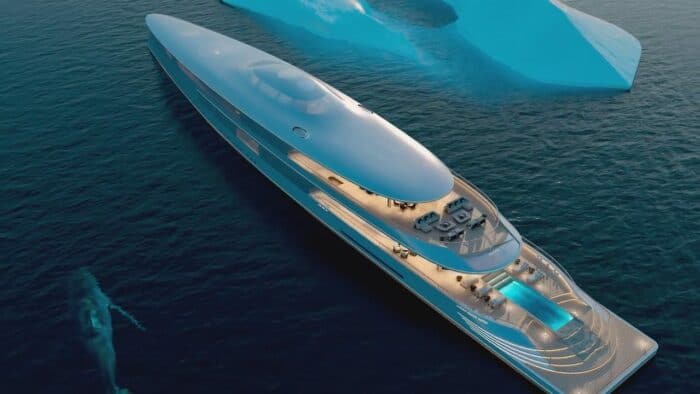
Aqua is a unique yacht in the yachting world which is why it garnered so much attention in the first place. It’s the first mega yacht that runs on a fully operational liquid hydrogen and fuel cell system that features two hydrogen engines that can produce 1,341 horsepower. The top speed is 17 knots and the Aqua has a cruising speed of 12 knots. The total range is 3,750 nautical miles. The liquid hydrogen is stored in two 28-ton vacuum sealed tanks where it can be held at -253 degrees C. The only exhaust is water.
What Does the Interior of the Aqua Yacht Look Like?

The Aqua has 7 suites meant to house up to 14 guests at any given time. Two of those suites are larger VIP cabins. The ceilings throughout are 9 feet and stretch as high as 12.5 feet elsewhere thanks to the luxury Sinot yacht architecture. The vessel has room for a crew of 31 as well. The beach deck lounge aboard the boat alone looks like a luxury hotel space.
The Aqua features a bow observation room which is surrounded by windows to give a panoramic view of the ocean which has been described as the “ultimate superyacht owners lounge.” In addition, there’s a movie theater on the upper deck. It also includes a wellness center with a hydro massage room. You can also do some yoga in a workout space. There’s a fully equipped gym, a beauty salon, and even a hairdresser.
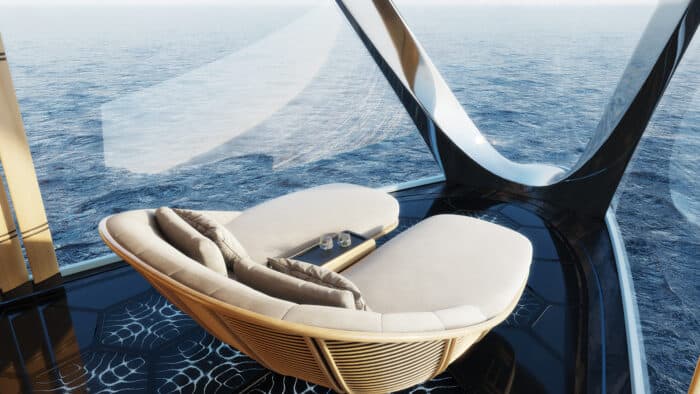
Up on the main deck there’s a luxury swimming pool that even includes a waterfall. One of the yacht’s defining features is the spiral staircase that covers all five decks and is covered by a skylight. On the way up it also offers a view of the interior of the hydrogen fuel tanks so you can see just what 56 tons of ultra cold liquid hydrogen looks like as you move between decks.
The tender garage has an array of toys such as jet skis while the main deck features a beach club with a dining area designed for all 14 guests and a lounge that converts into the cinema space.
What Yacht Has Bill Gates Actually Been On?
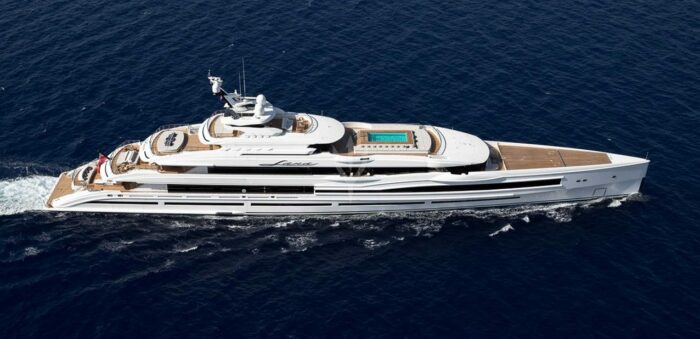
Bill Gates does seem to like yachts, just not enough to spend his money owning one, and that’s fair. Yachts cost millions to maintain every year. No one got rich spending millions to maintain a boat.
That said, Bill Gates has not only vacationed on yachts – he spent his 66th birthday on one – he also got married on a yacht.
In 2021, Gates made the news when he celebrated his 66th on board a luxury yacht called the Lana alongside Jeff Bezos. He spent $2 million to charter the yacht for a week and flew 50 guests out to celebrate with him.
The Lana is a 351 foot yacht with room for 12 guests and a cruising speed of 12 knots with a max speed of 18 knots. The master suite is 1,184 square feet. The room features his and hers walk-in dressing rooms and a private terrace.
Elsewhere on board you’ll find a piano in the lounge area as well as a full gym for working out. There’s both a sauna and a well-appointed spa as well. On deck you can head to the beach club or take a dip in the pool.
There are three tenders in the garage alongside a bunch of toys including various jetskis, a seabob, wakeboards, WindSurfers, fishing equipment, scuba diving equipment and more.
Back in 2014, Gates rented an even more expensive yacht, the $5 million per week Serene, to go on a vacation with his family. The Serene, once owned by Russian vodka magnate Yuri Shelfer before being purchased by the crown prince of Saudi Arabia, clocked in at a massive 450 feet making it one of the world’s biggest and even had its own on board submarine
The Serene features 7 decks, a saltwater pool, a climbing wall, a surprisingly large library, health spa, outdoor cinema and a nightclub. This is all spread across 48,000 square feet.
It’s also been confirmed that Gates met his wife Melinda on a yacht owned by Paul Allen, the co-founder of Microsoft, all the way back in 1994.
Why Do People Think Bill Gates Owns the Aqua?
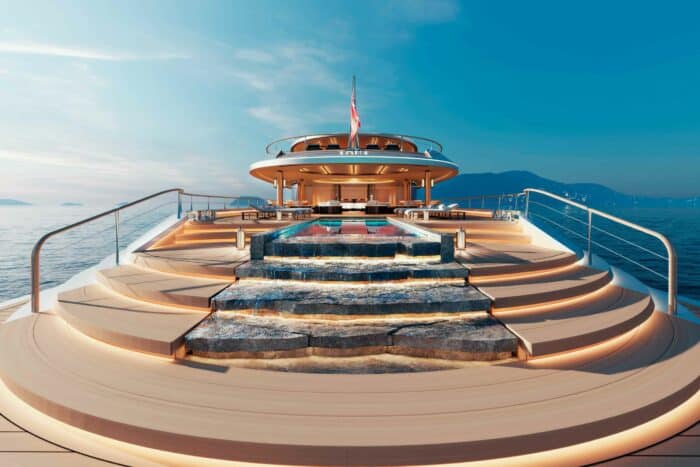
It’s easy to see why people may have thought Gates owned the Aqua when you consider a handful of factors. First, as mentioned, we have lots of evidence that Bill Gates really does enjoy luxury yachts. The extremely high price tag was something that only a few people in the world are going to be able to afford and Gates, who doesn’t own a yacht, seems like a likely candidate for those reasons.
In addition, Gates has spent several years now as a climate activist and has supported a number of green technologies. A yacht that runs on hydrogen seems like something he would support as well. So, with no real evidence, the circumstantial evidence was enough to easily convince people. Once it’s presented as fact on the internet, and it was in many articles and videos, few people had reason to question it.
The Bottom Line
The mega yacht known as the Aqua has a price tag of $645 million and it runs on clan burning hydrogen fuel. The only byproduct of its operation is water, making it a very environmentally friendly yacht. It made waves, so to speak, when it debuted at the Monaco Yacht Show in 2019. Rumors soon began to spread that billionaire and known climate activist Bill Gates had ordered one for $600 million. However, despite many videos and articles that refer to him as the owner, the truth is no one bought the Aqua at the yacht show and, as of 2023, Bill Gates does not own a yacht at all. He is know to charter extremely luxurious yachts for vacations and parties, such as the Lana and the Serene, but he does not own any just now.
My grandfather first took me fishing when I was too young to actually hold up a rod on my own. As an avid camper, hiker, and nature enthusiast I'm always looking for a new adventure.
Categories : Yachts
Leave a Reply Cancel reply
Your email address will not be published. Required fields are marked *
Save my name, email, and website in this browser for the next time I comment.
More in Yachts
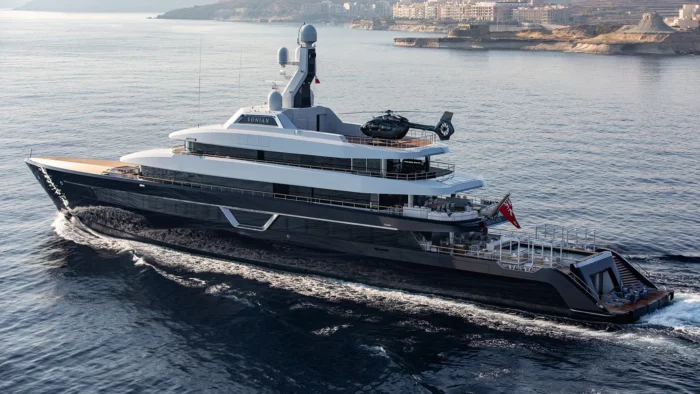
Lonian Yacht: An Insider's Guide
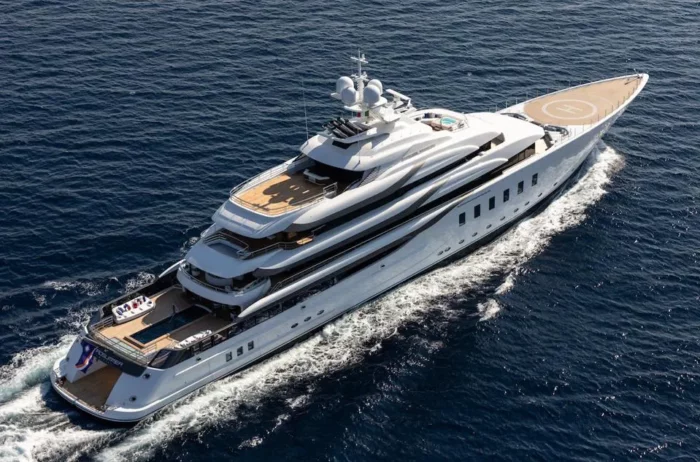
A Closer Look at the Madsummer Yacht
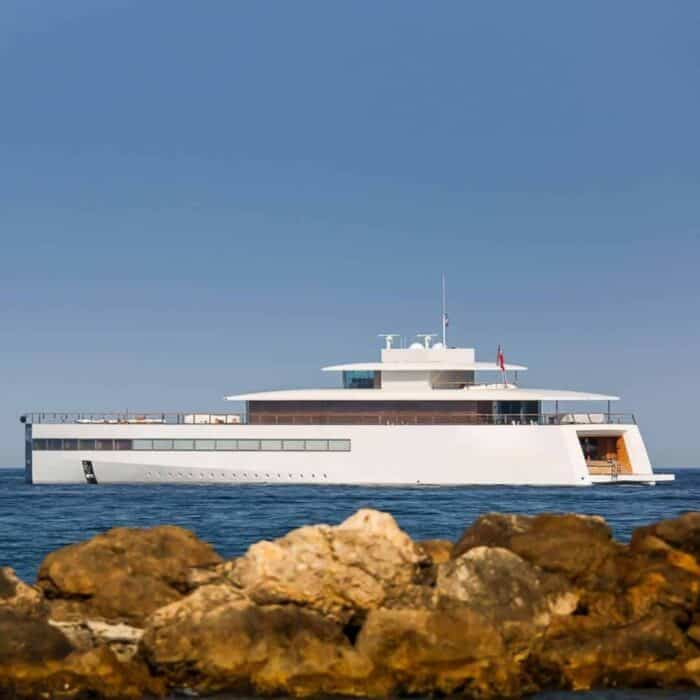
Your Insider’s Look at Steve Jobs’ Yacht Venus
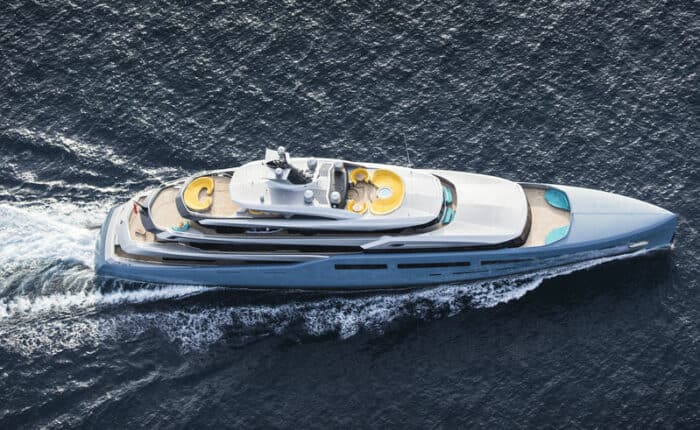
Your Insider’s Guide to the Aviva Yacht

The People’s Poncho Review and Ratings

Oru Lake Kayak Review

What Is A Gunwale?

131 of the Best Hawaiian Boat Names

167 Patriotic Boat Names
About boatsafe.
Established in 1998, BoatSafe is your independent guide into the world of boating, fishing, and watersports. We provide expert insights and detailed guides to help you find products tailored to your needs and budget.
Contact Boatsafe
- Address: 4021 West Walnut Street. Rogers, AR 72756
- Phone: (479)339-4795
- Email: [email protected]
Site Navigation
- How We Test
- Corrections Policy
- Privacy Policy
- Terms & Conditions
- Editorial Policy
- Affiliate Disclosure
Our Reviews

All content is © Copyright 2024. All rights reserved.

IMAGES
VIDEO
COMMENTS
Fuel prices can vary but typically costs between €0.80 and €1.30 per litre. Yacht charter, sales and management company West Nautical added: "Fuel costs should be at the top of any yacht owner and captain's minds for two reasons: to minimise costs as well as reduce the environmental impact of burning unnecessary fuel.
Understanding Yacht Fuel Consumption Fuel consumption in yachts is influenced by several factors, including the yacht's size, engine type, cruising speed, and conditions at sea. Here, we break down these elements to give you a clearer picture. Yacht Size and Engine Type Yachts come in various sizes, from smaller 40-foot models to massive 100-foot plus luxury liners. Generally, the larger the ...
Fuel: One of the biggest expenses is fuel, as superyachts are thirsty machines. As an example, a 230-foot yacht will use around $2,000 of fuel per hour while underway at 20 knots. A smaller yacht will use much less fuel, so a 150-foot yacht will use around 150 gallons per hour at a rough cost of around $500/hour.
So how much do they really consume? According to the Yachting Pages, the longest Superyacht in the world, 180m M/Y Azzam, holds 1,000,000 litres of fuel. To put it into perspective, that is the equivalent of filling a regular hatchback car 23,800 times or six Boeing 747 commercial airliners.
Yes, our yacht operating cost calculator can output a budget suitable for this situation. Adjust the owner use to 2 (minimum value), owner slider to 0, crew slider to 10%, Administration to 10%, Fuel and Dockage to 0, Maintenance to 10% and then Capital Repairs to 0. This will remove all of the large charges associated with owner use and vessel ...
Generally speaking, a superyacht typically holds anywhere from 15,000 to 50,000 gallons of fuel, though some larger vessels can hold upwards of 200,000 gallons. The range and cruising speed of a superyacht, as well as the type of engines used on the yacht, are also key factors in determining the amount of fuel the yacht will need to store.
Looking for a yacht fuel cost calculator? This post helps you calculate the expense of your trips and breaks down the formulas used to figure it out.
Fuel - The captain or engineer should be able to provide the fuel consumption per hour at any given speed, so if a yacht owner knows roughly how much he wants the boat to travel, then he can estimate the total fuel consumption and budget the fuel cost. There is also the fuel cost for generators, particularly at anchor. A typical 150-foot motor yacht cruising at 12 knots will consume in the ...
A smaller yacht will use much less fuel, so a 150-foot yacht will use around 150 gallons per hour at a rough cost of around $500/hour. Assuming a figure of 500 hours of cruising time a year, that's a total of $250,000 (excluding all the time spent at anchor with generators running).
Yacht fuel, a vital element for powering watercraft and setting sail into the open waters, plays a crucial role in the maritime industry. Whether you're a seasoned yachtie or a sailing enthusiast, understanding the intricacies of yacht fuel is essential. This article serves as a guide, shedding light on the types of yacht fuel, fuel efficiency, environmental concerns, and more.
Motor yachts can use a variety of fuel types, including diesel, gasoline, biodiesel, and electric. Diesel engines are commonly used in larger motor yachts that require a lot of power, while gasoline engines are often used in smaller sporty yachts that are designed for speed and agility. Biodiesel is often used by eco-conscious yacht owners who ...
The price of fuel can vary because of the market price, but it can also depend on whether the yacht is a private or a commercial one. Duty-free diesel is much less expensive, but it is subject to many regulations to be used. Within the price, there are also other costs, such as port taxes, which can vary from 1 cent per liter to 5 cents per liter.
How to measure your yacht fuel consumption per hour Yachts are quite similar to other vehicles in the sense that they work through fuel. Similarly to any other vehicle, it is important to calculate the yacht fuel consumption per hour before you plan a trip or before you purchase a vessel. Fuel consumption is also a good comparison base between boats. Whether before going on a trip, or buying a ...
A comprehensive breakdown of your charter costs and fees. When you begin planning a luxury yacht charter it is important to be aware of what is included in the cost of booking your dream charter yacht. Although a yacht will have a base charter fee, this may or may not include additional expenses such as food and fuel and this is subject to the terms and conditions within the charter contract ...
Julia Skoptsova, founder of brokerage firm Smart Yachts, estimates that the cost of insuring a 50-meter (164 foot) yacht is around €60,000 ($73,000), while fuel costs could run up to €232,000 ...
That's Antibes to Miami with fuel to spare in the yacht's 23,757-gallon fuel tanks. The choice of using lightweight aluminum was also a major factor in increasing the yacht's efficiency.
In some cases we had to estimate the size of houses from satellite images or photos and the use of private aircraft and yachts by and .
Many world-renowned superyachts cost hundreds of millions (Dilbar is worth $600 million), but have you ever wondered how much it costs to get these floating beasts of the seas from one point to another? Dilbar yacht is considered one of the largest yachts in the world in volume.
Discover how much fuel does a boat use per hour with this comprehensive guide. Learn to optimize fuel efficiency and save money.
In general, a 50-foot yacht might have a fuel capacity of around 500-1,000 gallons, while a 100-foot yacht could have a fuel capacity of 5,000 gallons or more. Again, these numbers vary widely depending on the specific yacht in question. Fuel capacity is a critical consideration for yacht owners. Knowing how much fuel your yacht can hold, and ...
Used 30-foot motor yacht. $55,000 - $328,500. $12,000 - $28,000. 1. The average cost of owning a new 30-foot sailing yacht. On average, a small brand-new sailing yacht can cost anywhere from $50,000 to $200,000 or more. This price range typically includes basic features like a cabin, galley, and bathroom, as well as a mast, sails, and rigging.
Explore the ultimate 2024 Mega Yacht Guide. Discover luxury, design, and performance. Find your dream mega yacht with YATCO today!
How Fast is the Aqua Yacht? Aqua is a unique yacht in the yachting world which is why it garnered so much attention in the first place. It's the first mega yacht that runs on a fully operational liquid hydrogen and fuel cell system that features two hydrogen engines that can produce 1,341 horsepower.